Maharashtra, the third largest state in India, is home to a rich diversity of bird species. With its varied landscapes ranging from forests to grasslands, wetlands to mountains, Maharashtra provides a perfect habitat for a wide array of avian species.
Some of the most commonly sighted birds in the state include Asian Paradise Flycatcher, Black-winged Kite, Common Kingfisher, Indian Pitta, and Red-vented Bulbul.
Additionally, Maharashtra is also home to some rare and endangered species of birds, such as the Indian Vulture, the Lesser Florican, and the Beautiful Sunbird.
Maharashtra’s bird diversity and abundance make it a haven for bird enthusiasts and nature lovers alike.
1. Cotton Pygmy Goose
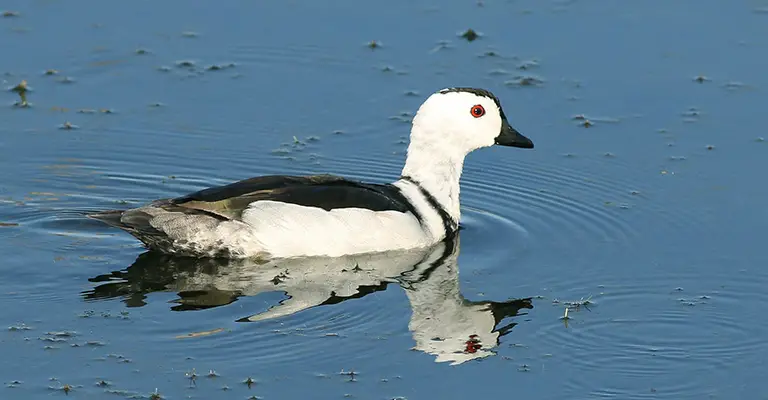
The Cotton Pygmy Goose is a small perching duck found throughout Asia and Southeast Asia, extending south to Queensland.
It stands out among waterfowl as one of the smallest in the world, with a quill-white coloration that helps it blend into its environment.
They often live alone or in pairs but form larger groups when looking for food near bodies of water with plenty of aquatic vegetation.
These birds are omnivorous, feeding on plants like grasses and seeds alongside insects such as beetles and termites.
Their diet also includes fish eggs and larvae from time to time. The cotton pygmies’ size makes them an easy target for predators so they use their agility to quickly escape danger whenever possible.
Scientific classification:
| Kingdom | Animalia |
| Phylum | Chordata |
| Class | Aves |
| Order | Anseriformes |
| Family | Anatidae |
| Genus | Nettapus |
| Species | N. coromandelianus |
Also Featured In: Most Common Birds in China, Birds of Karnataka
2. Lesser Whistling Duck
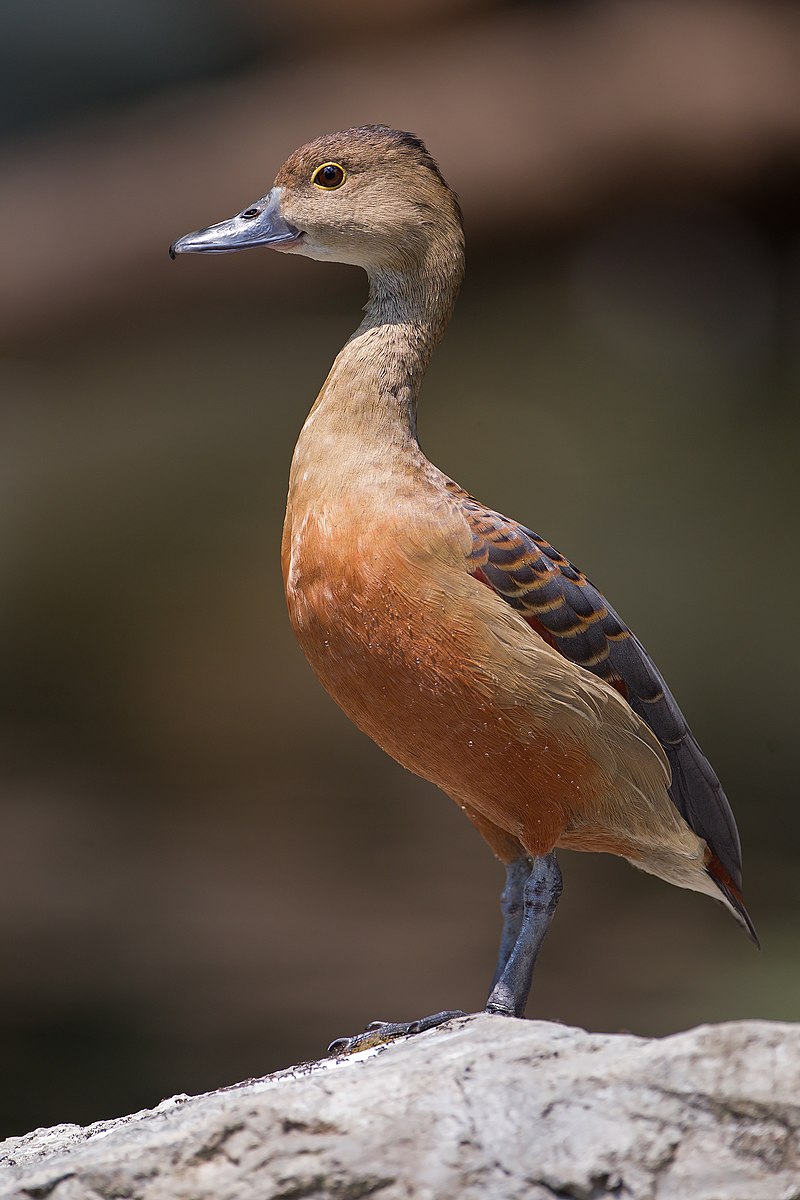
The Lesser Whistling Duck is a species of whistling duck found in the Indian subcontinent and Southeast Asia.
It has an unmistakable appearance, with its brown body, white-streaked wings and distinctive black tail feathers.
The adult ducks have red bills, eyes and legs with yellowish webbed feet for swimming.
They are generally nocturnal feeders but during the day they can be seen around lakes or wet paddy fields in flocks perching on trees or even building their nest inside tree hollows.
Their diet mainly consists of seeds from aquatic plants as well as small fish, mollusks and insects occasionally taken while wading or diving into water bodies to find food sources.
Scientific classification:
| Kingdom | Animalia |
| Phylum | Chordata |
| Class | Aves |
| Order | Anseriformes |
| Family | Anatidae |
| Genus | Dendrocygna |
| Species | D. javanica |
Also Featured In: Most Common Birds of Ko Samui, Ko Samet Birds You Need To Know
3. Grey Junglefowl
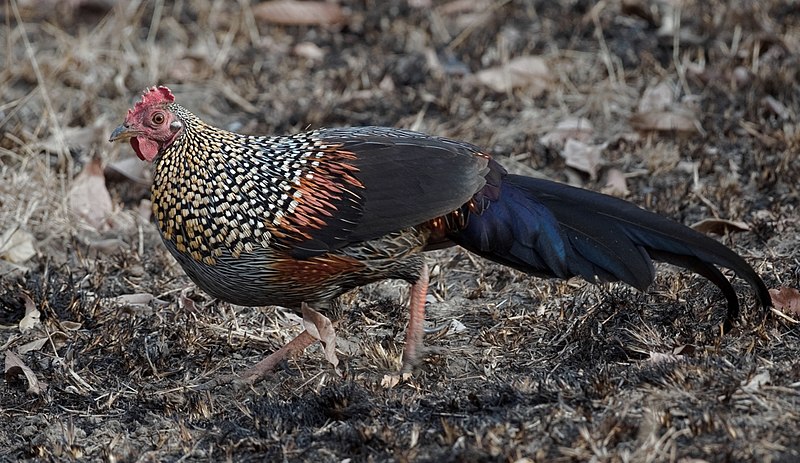
The Grey Junglefowl is a species of wild chicken, one of the ancestors to today’s domestic fowl. It has been named after.
Its discoverer Pierre Sonnerat and goes by many other names across different regions such as Komri in Rajasthan, Geera kur or Parda komri in Gondi etc .
These birds have their natural habitats mainly in India and Sri Lanka with some populations also found along South-East Asia.
They are usually seen foraging on ground under trees seeking food like insects, seeds and fruits from shrubs.
The males are usually characterized by grey plumage with tinges of brownish red colour around the neck area which is further highlighted when they spread out during courtship displays for mating purpose.
Overall these beautiful creatures can be identified easily becauseof its unique features making it an interesting wildlife species to observe.
Scientific classification:
| Kingdom | Animalia |
| Phylum | Chordata |
| Class | Aves |
| Order | Galliformes |
| Family | Phasianidae |
| Genus | Gallus |
| Species | G. sonneratii |
Also Featured In: Common Birds in India,
4. Indian Roller
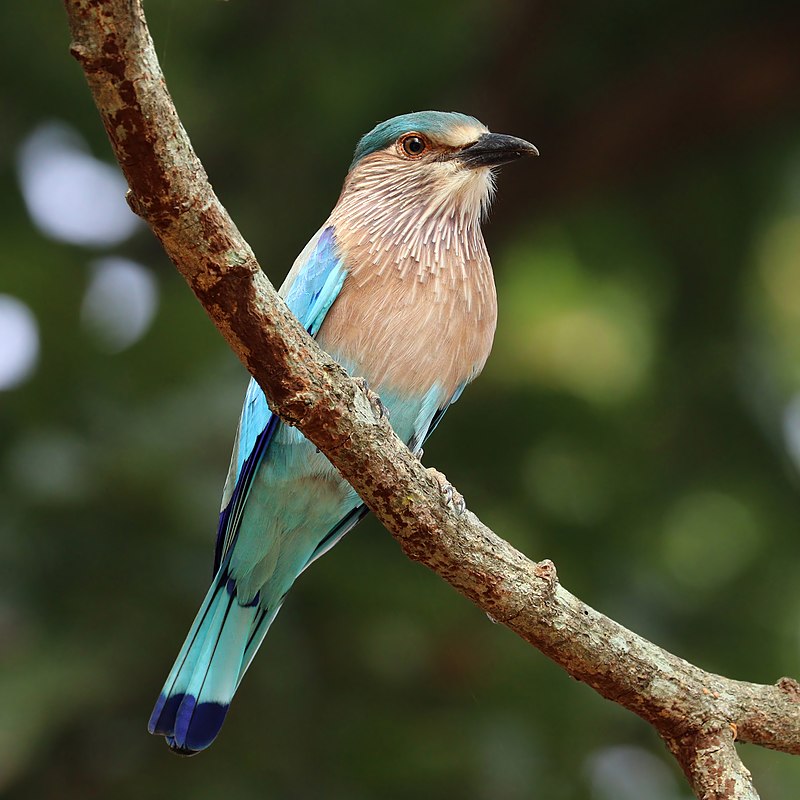
The Indian roller is a beautiful bird of the Coraciidae family. It has an average length of 12-13 inches and weighs 5.9 to 6.2 ounces with a wingspan of 26-29 inches.
Its face and throat are pinkish, while its head and back are brown with blue on its rump, light blue markings on one side of the wing, dark blue markings on other side making it easily distinguishable in flight.
Both male and female have same colouration but males tend to be slightly larger than females though they can only be differentiated when seen together closely due to similar colouring pattern between sexes.
The Indian Roller makes spectacular aerial dives from great heights during courtship display which attracts many viewers each year.
Scientific classification:
| Kingdom | Animalia |
| Phylum | Chordata |
| Class | Aves |
| Order | Coraciiformes |
| Family | Coraciidae |
| Genus | Coracias |
| Species | C. benghalensis |
Also Featured In: Birds You’ll Find in Kanha National Park, Birds That You’ll See in Kaziranga National Park
5. Painted Stork
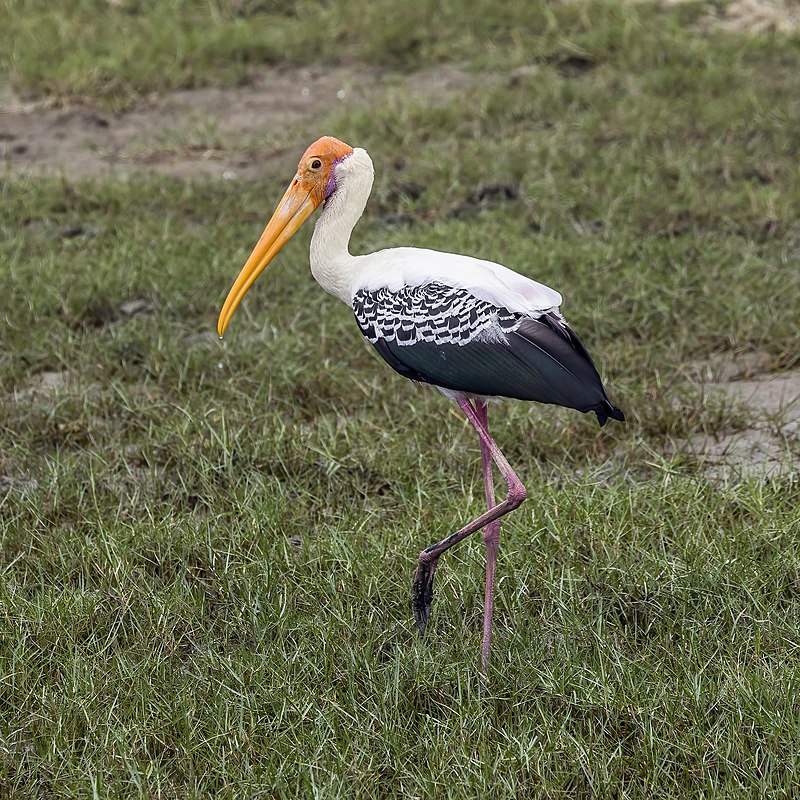
The Painted Stork is a large bird that belongs to the stork family. It has an impressive wingspan and can be found in tropical Asia, ranging from the Indian subcontinent all the way to Southeast Asia.
These birds are unique because of their pink tertial feathers, which gives them their name. They form flocks when they forage in shallow waters near rivers or lakes.
They dip their half-open beaks into water looking for food such as fish, frogs and other small aquatic creatures.
A distinctive feature of these birds is that during breeding season both males and females have red eyes with yellow rings around them.
This species also displays amazing cooperative behaviour when nesting; young storks help build nests by bringing material back to older ones who weave it together forming huge colonies on trees close to wetlands.
Scientific classification:
| Kingdom | Animalia |
| Phylum | Chordata |
| Class | Aves |
| Order | Ciconiiformes |
| Family | Ciconiidae |
| Genus | Mycteria |
| Species | M. leucocephala |
Also Featured In: Delhi Birds You Need to See, Big Birds that Live in Singapore
6. Great Indian Bustard
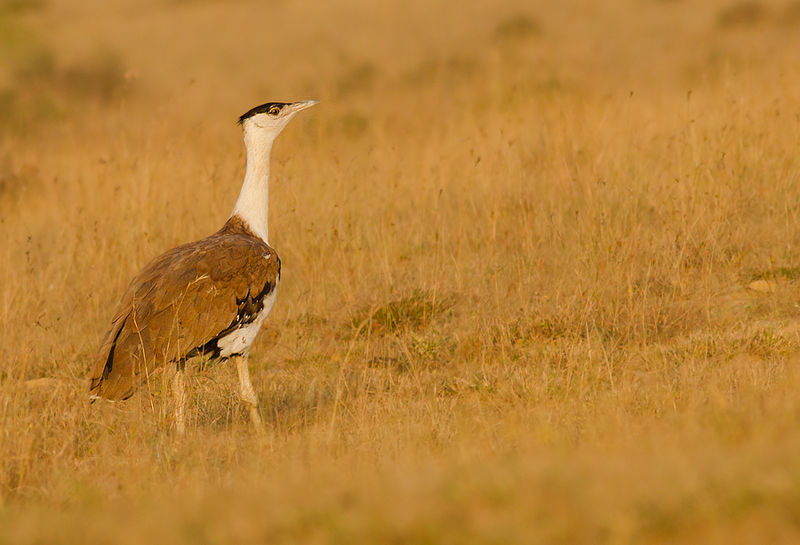
The Great Indian Bustard is a majestic bird found on the Indian subcontinent. It has an ostrich-like appearance, with its horizontal body and long bare legs making it one of the heaviest flying birds in the world.
Sadly, due to intense hunting and habitat loss their numbers have dwindled drastically since 2018 from 1,250 individuals to just 150.
This beautiful species needs our help as they are now critically endangered. Conservation efforts must be taken up urgently for them if we wish for future generations to experience these wonderful creatures in all their glory.
Scientific classification:
| Kingdom | Animalia |
| Phylum | Chordata |
| Class | Aves |
| Order | Otidiformes |
| Family | Otididae |
| Genus | Ardeotis |
| Species | A. nigriceps |
7. Red-Wattled Lapwing
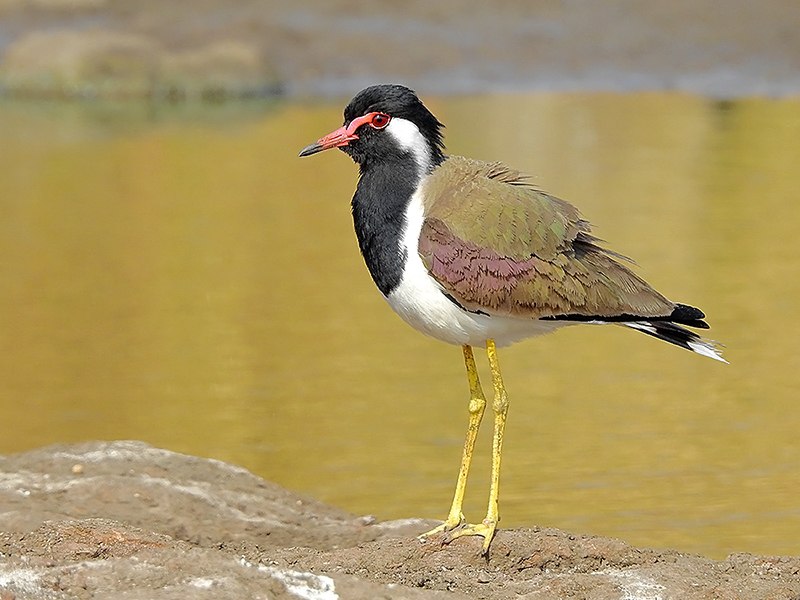
The Red-wattled Lapwing is an Asian bird belonging to the family Charadriidae. It has a distinctive loud call which led to it being nicknamed ‘did he do it’ by locals, due to its sound resembling the phrase.
These birds are usually found on open ground and cannot perch like other lapwings. They have black feathers with white wings, back and tail along with reddish wattles near their eyes that give them their name.
Red-wattled Lapwings feed mainly on insects but also eat some plant matter such as seeds or grains.
During breeding season they form strong pair bonds and make nests in shallow depressions of sand or soil lined with vegetation for incubating eggs during mating season before hatching out young chicks in around 25 days after laying eggs.
Scientific classification:
| Kingdom | Animalia |
| Phylum | Chordata |
| Class | Aves |
| Order | Charadriiformes |
| Family | Charadriidae |
| Genus | Vanellus |
| Species | V. indicus |
Also Featured In: Birds of Goa, Birds that Live in Uttar Pradesh
8. Yellow-Wattled Lapwing
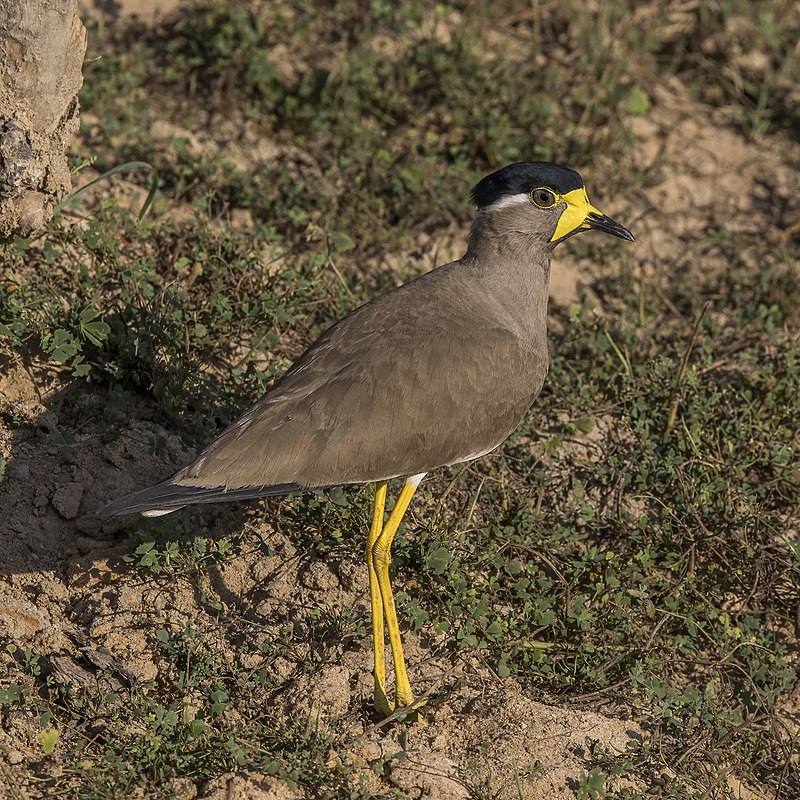
The Yellow-wattled Lapwing is a stunning bird native to the Indian Subcontinent. It has an unmistakable appearance, with its grey brown body and black cap contrasting sharply against its bright yellow legs and triangular wattle at the base of its neck.
Not only does this make it easily identifiable, but also makes it quite attractive in appearance.
The bird is capable of fast flight and has a sharp call which can be heard over long distances on dry plains across peninsular India.
Although they don’t migrate, they do make seasonal movements depending on rainfall patterns in their locale making them adaptive birds too.
Scientific classification:
| Kingdom | Animalia |
| Phylum | Chordata |
| Class | Aves |
| Order | Charadriiformes |
| Family | Charadriidae |
| Genus | Vanellus |
| Species | V. malabaricus |
9. White-Throated Kingfisher
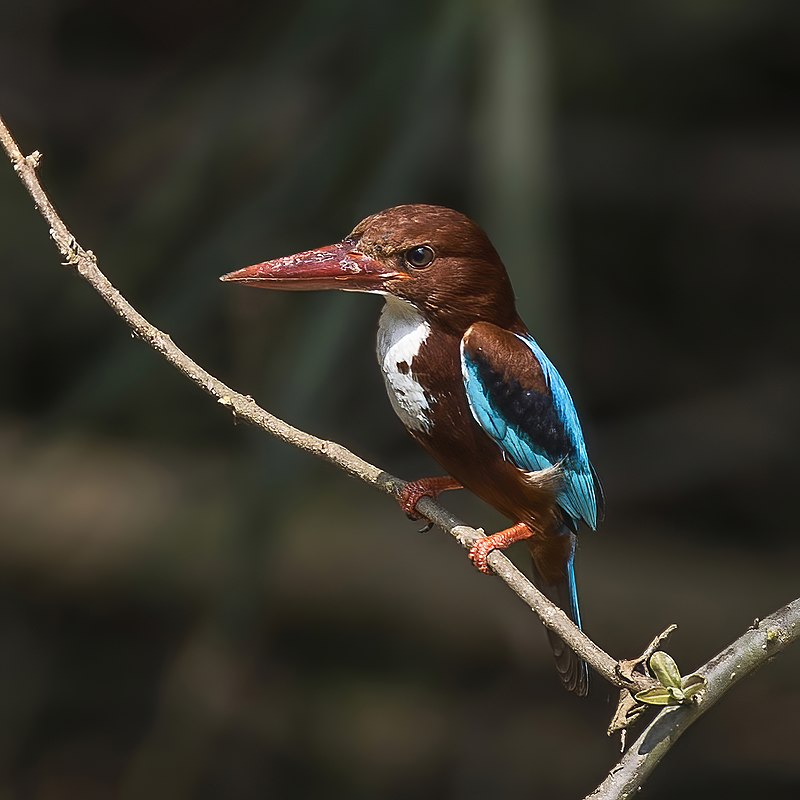
The White-throated Kingfisher is a beautiful bird with bright colors and distinct features. Its back, wings and tail are a deep blue while the head, breast, throat and belly are white.
It has two black stripes across its eyes which contrast nicely against its orange beak and feet.
These birds can often be found perching on tree branches or hovering over creeks in search of food like fish or small insects such as grasshoppers or crickets.
They use their sharp bill to pluck prey from water surfaces then swallow them whole after making adjustments for size by beating it against rocks if necessary.
The White-throated Kingfisher breeds during monsoon season when rainfall increases levels in rivers leading to an abundance of aquatic life that these birds love so much.
Scientific classification:
| Kingdom | Animalia |
| Phylum | Chordata |
| Class | Aves |
| Order | Coraciiformes |
| Family | Alcedinidae |
| Subfamily | Halcyoninae |
| Genus | Halcyon |
| Species | H. smyrnensis |
Also Featured In: Turkey Birds You Should Know, Lebanon Birds Live in Semi-Desert Areas
10. Blue-Faced Malkoha
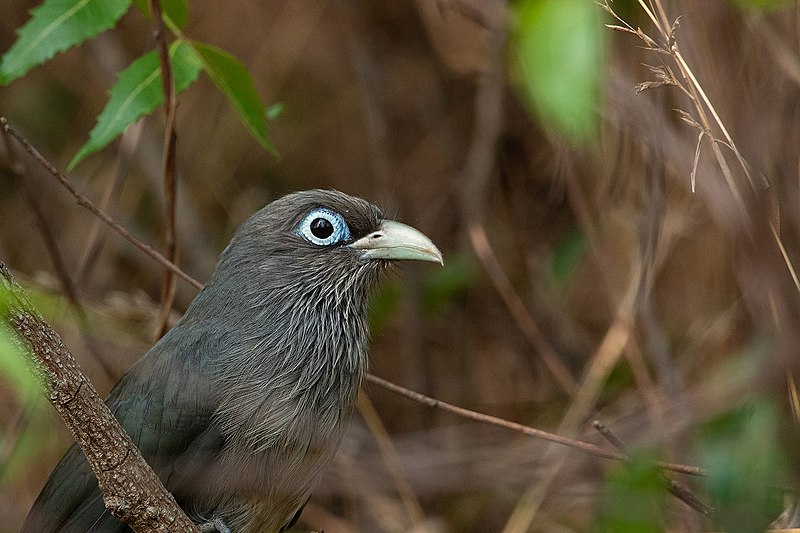
The Blue-faced Malkoha is a beautiful and unique bird which can be found in the scrub and deciduous forests of India and Sri Lanka.
It has an impressive waxy, dark blue-grey plumage on its upperparts with a long tail having graduated white-tipped feathers.
Its throat and chin are darker than other parts of its body but still have spiny pale feathers that branch out from it.
The lower belly usually displays a dusky hue while the wings are brownish grey at their base fading to light brown at tips.
This species also has distinctive green bill giving them their name ‘Small Green Billed’ malkohas’.
They mainly feed on insects or fruits depending upon availability making them omnivorous birds by nature.
Scientific classification:
| Kingdom | Animalia |
| Phylum | Chordata |
| Class | Aves |
| Order | Cuculiformes |
| Family | Cuculidae |
| Genus | Phaenicophaeus |
| Species | P. viridirostris |
11. Yellow-Footed Green Pigeon
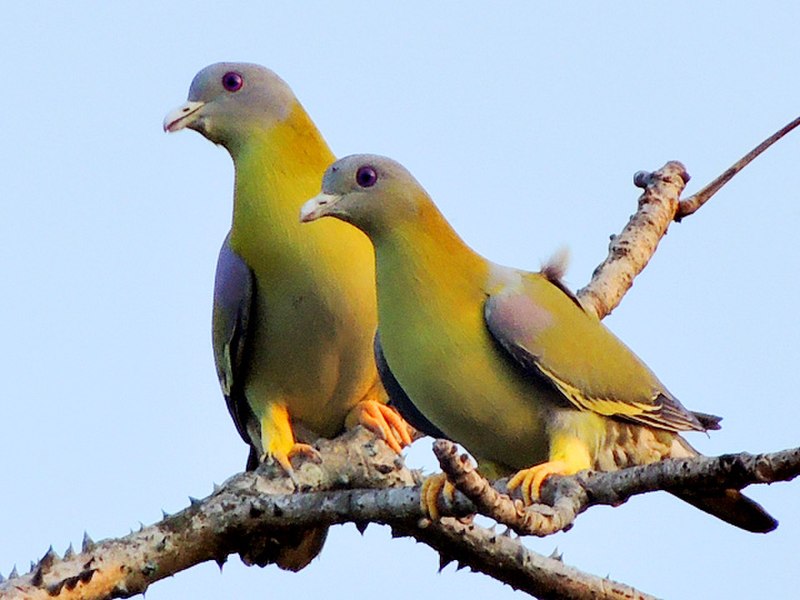
The Yellow-footed Green Pigeon is a common species of green pigeon found in the Indian subcontinent and parts of Southeast Asia. It has yellow feet and legs, with emerald green body plumage that stands out from its surroundings.
This vibrant bird is also the state bird of Maharashtra, where it’s called “Haroli” or “Hariyal”. Its diet consists mainly of fruit like Ficus racemosa, Terminalia arjuna, Syzygium cumini etc., which are important sources for wild animals.
With their impressive vocalizations and adaptability to different environments they have become popular among city dwellers as well.
The Yellow-footed Green Pigeon plays an important role in maintaining healthy ecosystems by providing food to other wildlife while dispersing seeds through defecation – helping propagate new plants across vast areas.
Scientific classification:
| Kingdom | Animalia |
| Phylum | Chordata |
| Class | Aves |
| Order | Columbiformes |
| Family | Columbidae |
| Genus | Treron |
| Species | T. phoenicopterus |
Also Featured In: Birds that You’ll Find in Kolkata,
12. Lesser Crested Tern
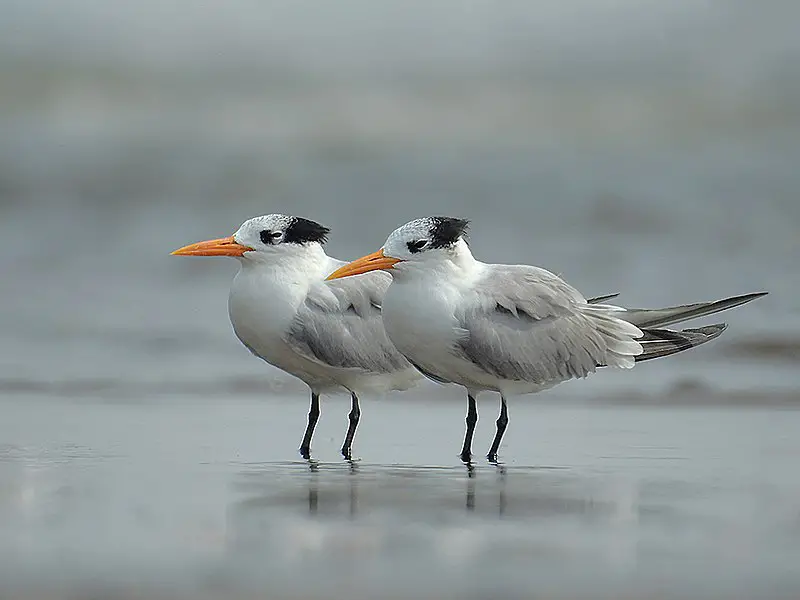
The lesser crested tern is a beautiful bird belonging to the Laridae family. It can be found breeding in subtropical coastal parts of the world, mainly from Red Sea across Indian Ocean.
Its genus name comes from Ancient Greek word Thalasseus which means fisherman and its specific bengalensis refers to Bengal, historically referring to much of northern India and Bangladesh.
The adult has white plumage with grey on wings and back; black cap extending behind eye; long pointed bill yellow tipped red at base, orange legs and feet.
They feed primarily by plunge-diving for fish near shore but may also take some insects or scavenge off boats or piers when given opportunity.
This species nests in colonies often on beaches or islands with other seabirds where it lays two eggs per clutch that are incubated for about a month before hatching.
Scientific classification:
| Kingdom | Animalia |
| Phylum | Chordata |
| Class | Aves |
| Order | Charadriiformes |
| Family | Laridae |
| Genus | Thalasseus |
| Species | T. bengalensis |
Also Featured In: Beautiful Indonesian Birds, Common Townsville Birds
13. Indian Spot-Billed Duck
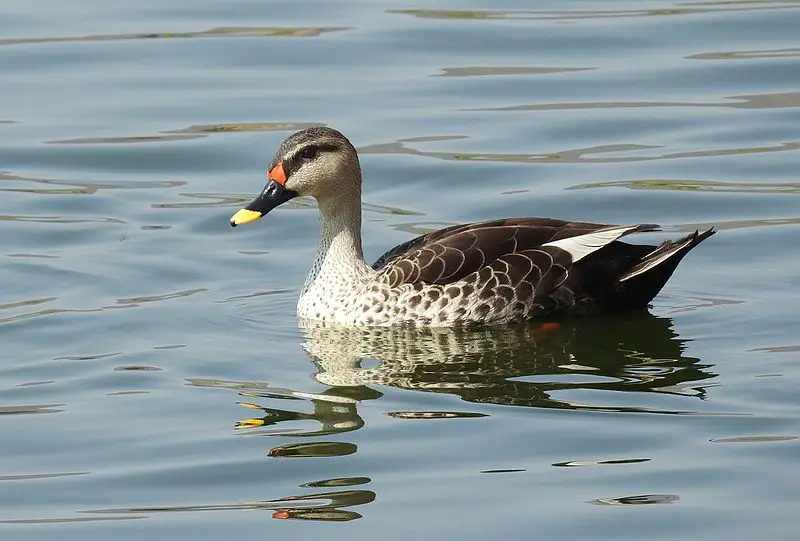
The Indian spot-billed duck is a large dabbling duck found throughout freshwater wetlands in the Indian subcontinent. It gets its name from the red spot at the base of its bill, which is only seen on mainland birds.
Distinctive white tertials form a stripe down their sides, making it easy to recognize them even when far away.
They feed mainly on aquatic vegetation and invertebrates including molluscs and insects but will also consume some grains and fruits during dry seasons or if food becomes scarce.
When not breeding they can be found in flocks with other ducks such as teals or pochards.
Breeding season varies by region but typically takes place between March–May, where pairs build nests close to water usually among reeds or grasses lining ponds, marshes, rivers etc..
The female incubates her eggs for around 24 days before hatching occurs; afterwards both parents care for their young until they fledge after 45-50 days old.
Scientific classification:
| Kingdom | Animalia |
| Phylum | Chordata |
| Class | Aves |
| Order | Anseriformes |
| Family | Anatidae |
| Genus | Anas |
| Species | A. poecilorhyncha |
Also Featured In: Native Pakistani Birds, Birds that Migrate to Sri Lankan
14. Painted Sandgrouse
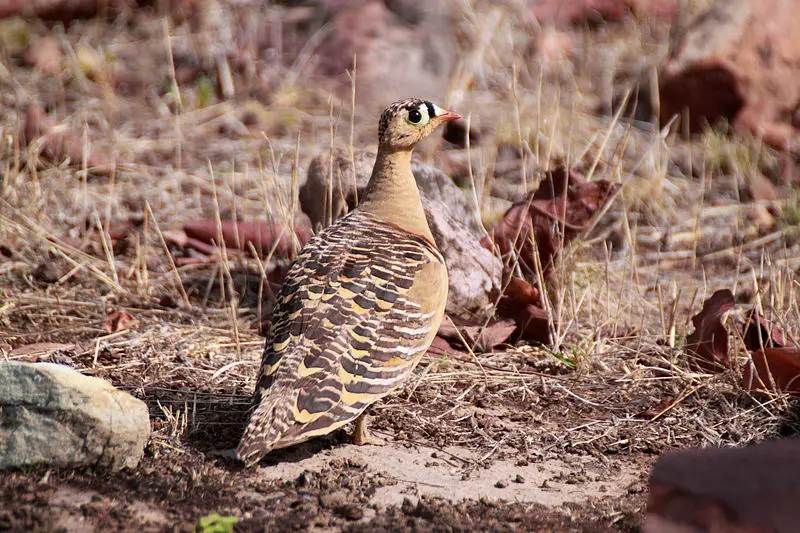
The Painted Sandgrouse is a species of bird found in Bangladesh, India and Pakistan. It belongs to the sandgrouse family and has an average size compared to other similar birds.
Johann Friedrich Gmelin was the first one who formally described it back in 1789 for Carl Linnaeus’s Systema Naturae.
The most remarkable feature about this bird is its gorgeous coloration on both males and females.
They have white patches across their wings with brownish-gray feathers covering their bodies along with some black markings around the head and neck area.
They are also quite capable fliers as they often cover long distances from water sources during dry seasons when food becomes scarce.
All these features make them truly unique among all other grouse-like birds out there.
Scientific classification:
| Kingdom | Animalia |
| Phylum | Chordata |
| Class | Aves |
| Order | Pterocliformes |
| Family | Pteroclidae |
| Genus | Pterocles |
| Species | P. indicus |
15. Indian Courser
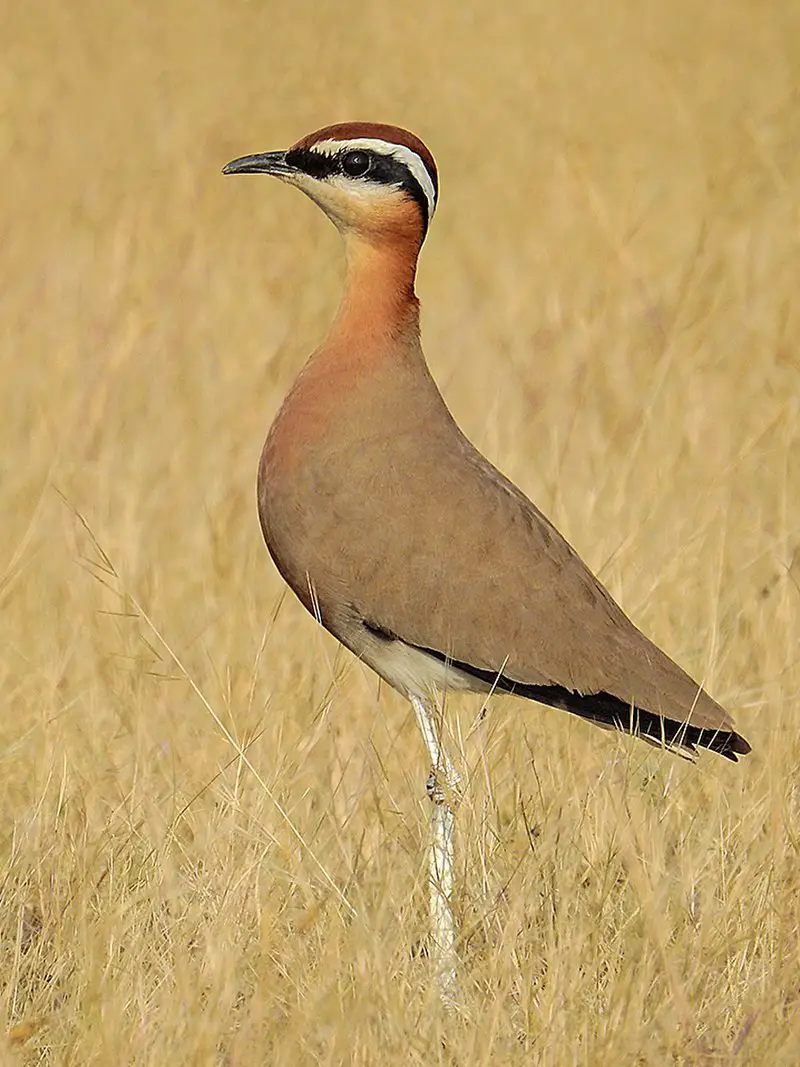
The Indian courser is a species of bird found in South Asia, mostly around the Ganges and Indus river systems. It belongs to the family of ground birds known as “coursers”.
Small groups can be seen foraging on insects amongst dry and open semi-desert areas.
The first scientific description was by Johann Friedrich Gmeli in 1789, with them being quite small but striking creatures due to their white stripes running down its back and black neck rings.
They prefer warm climates with little rainfall or snowfall; however they are still very adaptable when it comes to food sources such as grasshoppers, beetles or spiders which make up most of their diet.
Although not endangered yet, there’s concern that humans may encroach upon its natural habitat leading to population decline if left unchecked
Scientific classification:
| Kingdom | Animalia |
| Phylum | Chordata |
| Class | Aves |
| Order | Charadriiformes |
| Family | Glareolidae |
| Genus | Cursorius |
| Species | C. coromandelicus |
16. Indian Paradise Flycatcher
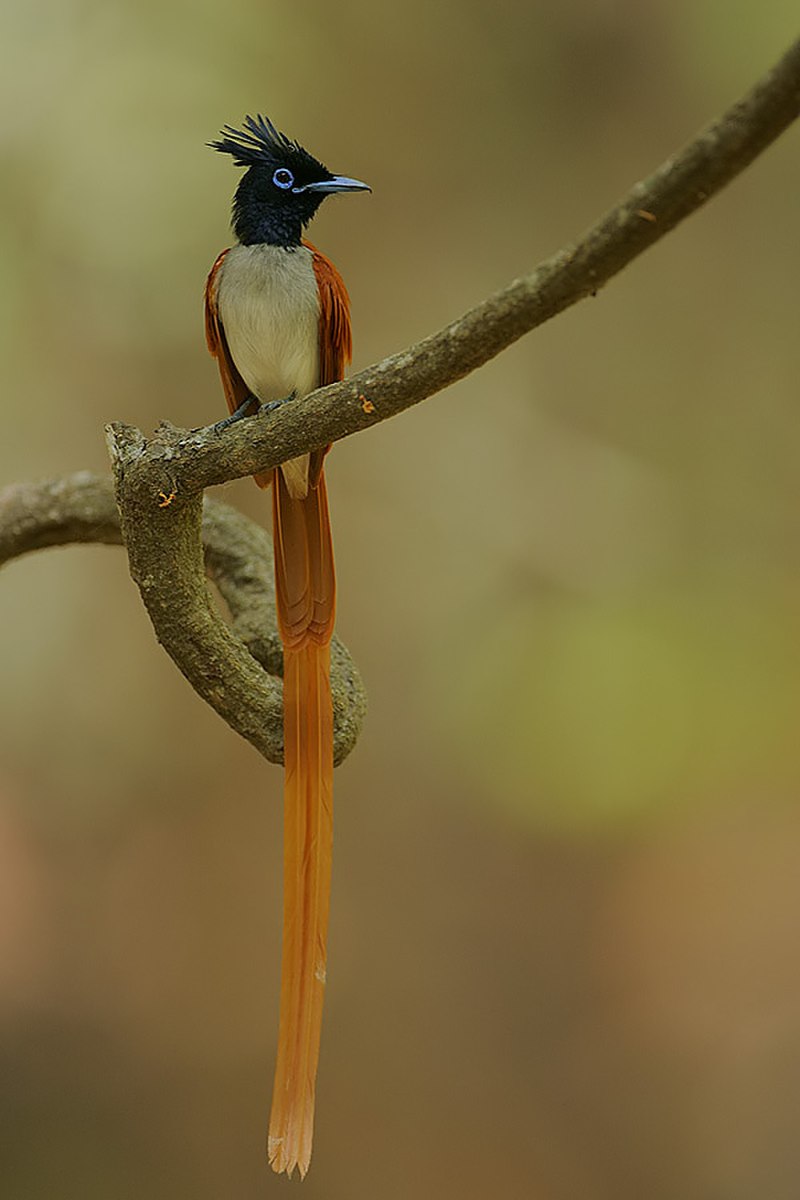
The Indian paradise flycatcher is a beautiful bird native to Asia. It has an overall black and rufous plumage, but the males have elongated central tail feathers that really stand out.
This species is considered stable globally, so it is listed as Least Concern on IUCN’s Red List of Threatened Species.
The range of this passerine extends from India in the South Asian subcontinent all the way up to Central Asia and Myanmar.
Despite its beauty, sadly these birds are also threatened by loss of habitat due to urbanization and deforestation caused by humans- we must do our best to protect them.
Scientific classification:
| Kingdom | Animalia |
| Phylum | Chordata |
| Class | Aves |
| Order | Passeriformes |
| Family | Monarchidae |
| Genus | Terpsiphone |
| Species | T. paradisi |
Also Featured In: Black And White Birds You Don’t Know About,
17. Indian Golden Oriole
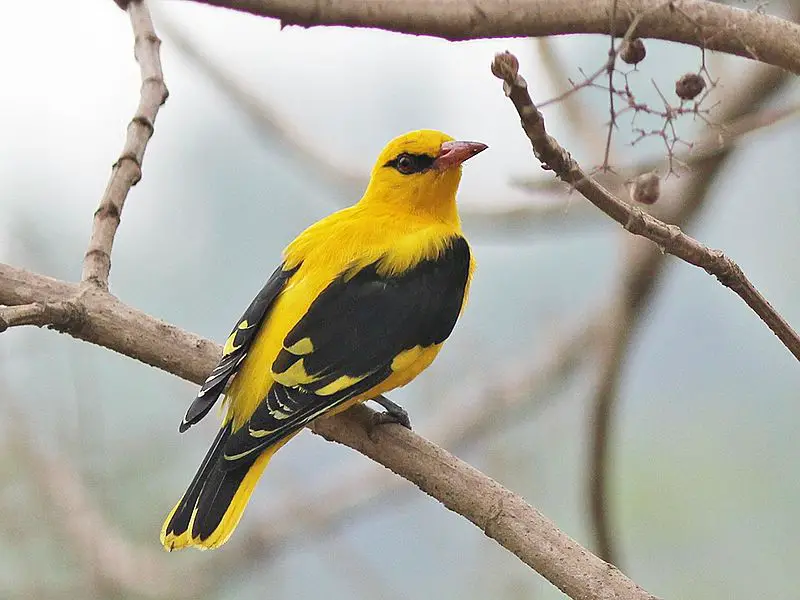
The Indian golden oriole is a species of oriole found in the Indian subcontinent and Central Asia.
It has been identified as a full distinct species from Eurasian golden Oriole by its black eye stripe which extends behind the eyes.
With its bright yellow body, black wings and tail with white patches, this bird stands out among other birds in its region.
The males are more brightly colored than females but both share similar features such as long pointed bills and strong legs for perching or hopping through trees.
They feed mainly on insects, fruits and nectar while their diet may also include small reptiles like lizards depending on availability of food sources around them.
This beautiful songbird can often be spotted during spring when they migrate to find suitable breeding grounds where they build nests high up in tree branches to lay eggs.
Scientific classification:
| Kingdom | Animalia |
| Phylum | Chordata |
| Class | Aves |
| Order | Passeriformes |
| Family | Oriolidae |
| Genus | Oriolus |
| Species | O. kundoo |
Also Featured In: Most Common Birds of Bihar,
18. Coppersmith Barbet
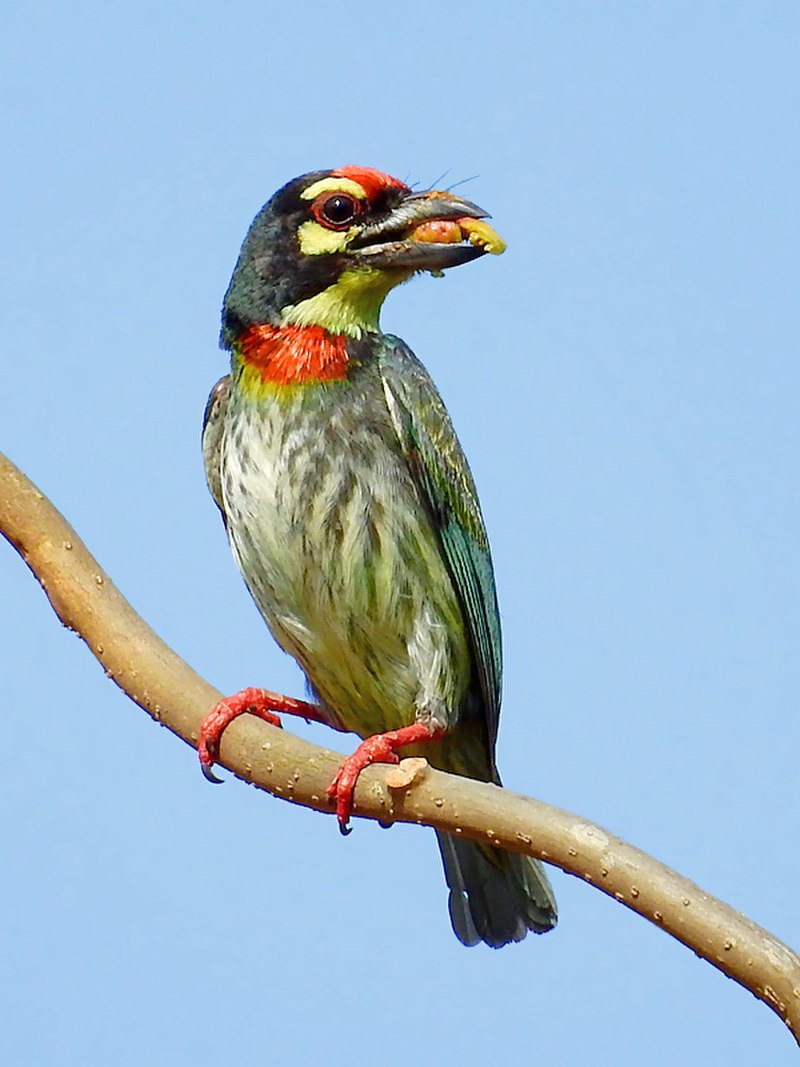
The Coppersmith barbet is an attractive Asian bird, easily recognizable by its bright crimson forehead and throat.
It has a call that sounds like a coppersmith striking metal with a hammer – hence its name.
These birds are found in the Indian subcontinent and parts of Southeast Asia where they build their nests inside trees, carving out holes for themselves.
They can often be seen perched high up on trees or wires during the day as they feed on fruit from nearby branches.
The vibrant colors of these birds make them stand out amongst other species in their habitat.
Scientific classification:
| Kingdom | Animalia |
| Phylum | Chordata |
| Class | Aves |
| Order | Piciformes |
| Family | Megalaimidae |
| Genus | Psilopogon |
| Species | P. haemacephalus |
Also Featured In: Most Common Types of Bangladeshi Birds, Common Birds of Mumbai
19. Brahminy Kite
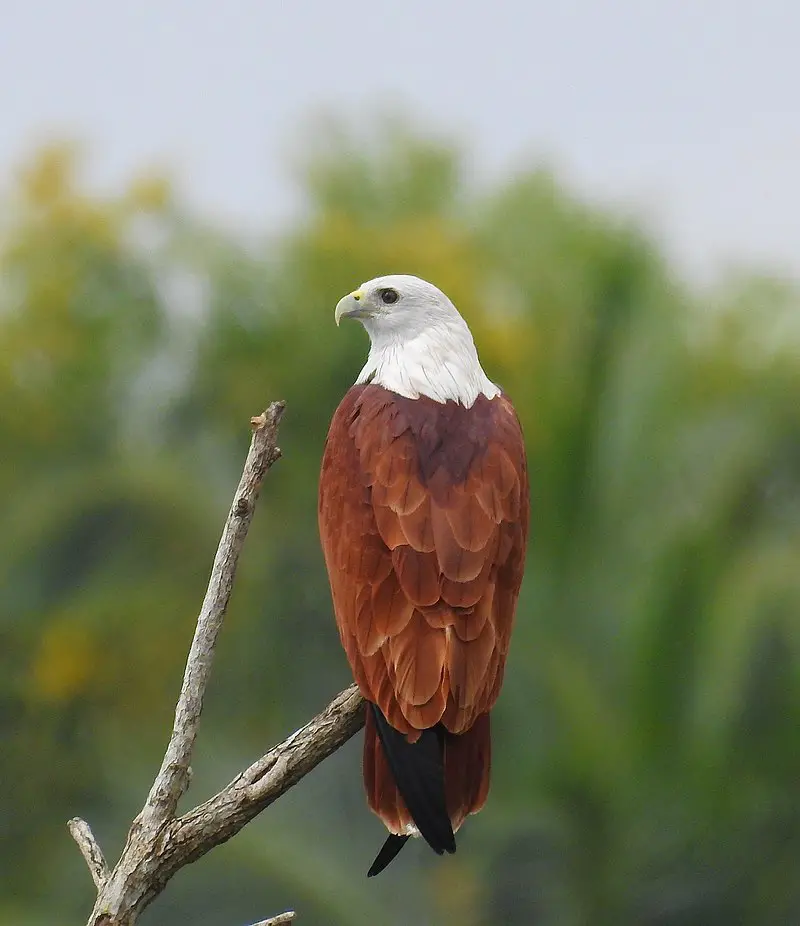
The Brahminy Kite is a majestic bird of prey native to the Indian subcontinent, Southeast Asia and Australia. It was formerly known as the red-backed sea eagle in Australia.
This medium-sized raptor has a distinctive white head with rufous brown feathers covering its body, making it easily recognisable from far away. The wingspan can reach up to 5 feet wide.
Brahminy kites are found mainly on coasts and inland wetlands where they feed mostly on dead fish or carrion left by other animals.
They also hunt for small mammals such as rodents or reptiles like lizards and snakes during dry spells when food sources become scarce.
These birds have adapted well over time and will even scavenge for food near picnic sites or urban areas if need be.
Overall these beautiful creatures are an important part of their local ecosystems which rely heavily upon them for keeping animal populations balanced through natural predation methods instead of manmade ones; this ensures that nature remains healthy so future generations may enjoy it too.
Scientific classification:
| Kingdom | Animalia |
| Phylum | Chordata |
| Class | Aves |
| Order | Accipitriformes |
| Family | Accipitridae |
| Genus | Haliastur |
| Species | H. indus |
Also Featured In: Birds that Live around Brisbane, Birds that Charles Darwin Studied
20. Asian Green Bee-Eater
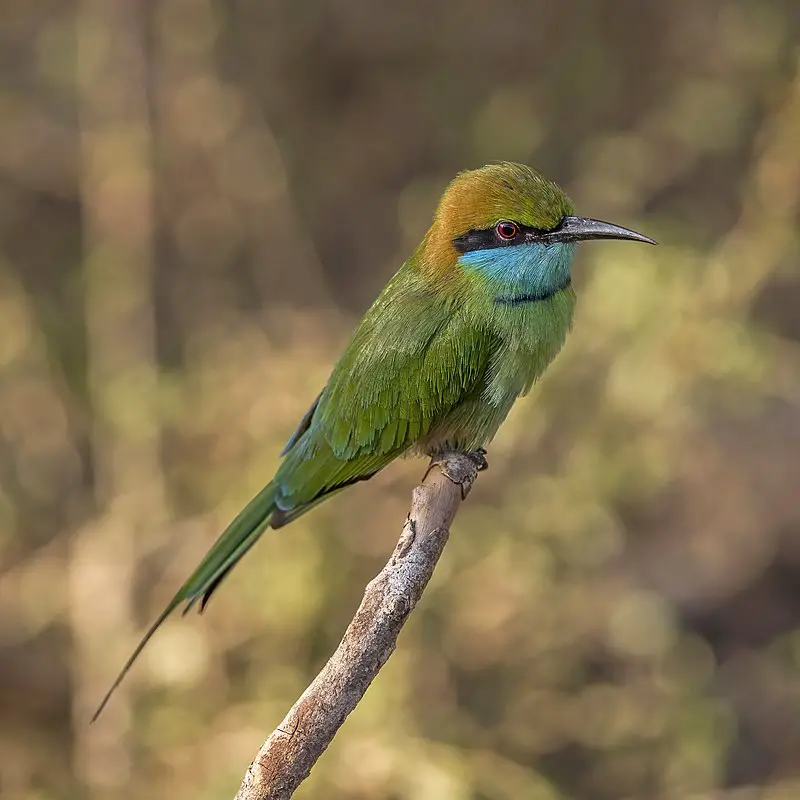
The Asian green bee-eater is a near passerine bird in the bee-eater family. It’s native to parts of Asia, stretching from Iran all the way over to Vietnam.
These birds are resident but tend to migrate seasonally and can also be found in Africa and Arabia.
They have bright green feathers on their upperparts with yellowish underparts, making them easy to spot when they’re flying around looking for insects like bees, wasps and dragonflies.
They usually nest burrows dug into sandy ground or riverbanks where they lay up to five eggs at once.
The Asian green bee-eater is an exciting species that has been popular among ornithologists since its discovery hundreds of years ago.
Scientific classification:
| Kingdom | Animalia |
| Phylum | Chordata |
| Class | Aves |
| Order | Coraciiformes |
| Family | Meropidae |
| Genus | Merops |
| Species | M. orientalis |
Also Featured In: Birds of Konkan,
21. Laughing Dove
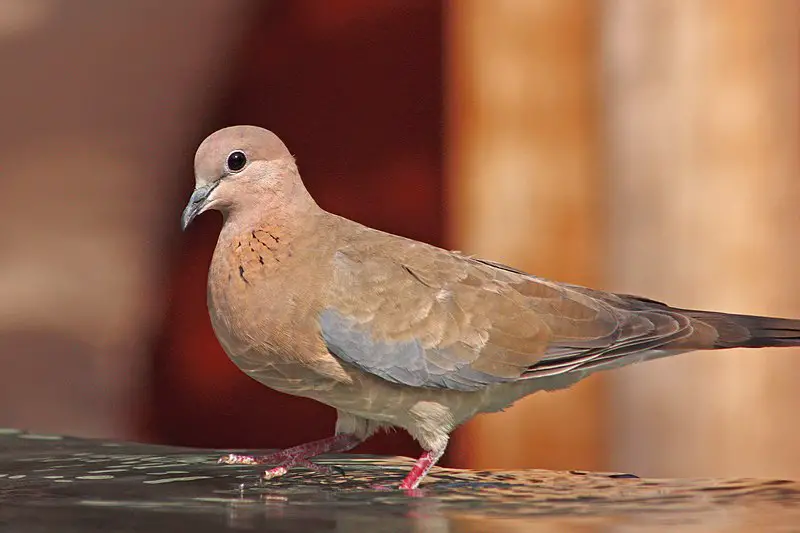
The Laughing Dove is a small and long-tailed pigeon found in dry, scrubby or semi-desert habitats. These birds are native to Africa, the Middle East, South Asia and Western Australia where they were released from Perth Zoo in 1898.
A unique feature of these doves is their call which sounds like low laughter – hence its name.
They form pairs when feeding on the ground, often near water sources such as pools or riverbanks. The diet of this bird consists mainly of seeds with some invertebrates also taking up part of it.
This species has adapted well to different environments due to its ability to find food resources easily even during times when other foods may be scarce.
Scientific classification:
| Kingdom | Animalia |
| Phylum | Chordata |
| Class | Aves |
| Order | Columbiformes |
| Family | Columbidae |
| Genus | Spilopelia |
| Species | S. senegalensis |
Also Featured In: Egyptian Birds, Most Common Western Australia Birds
22. Greater Flamingo
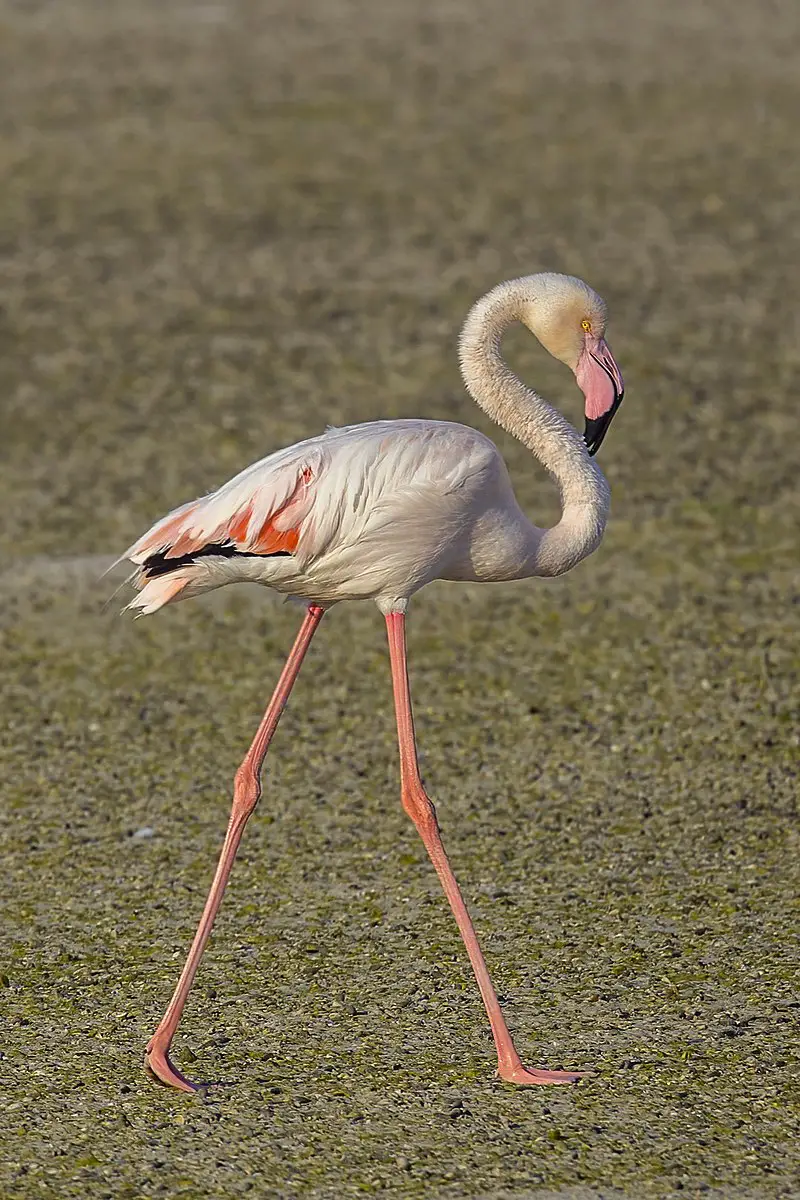
The Greater Flamingo is an impressive bird belonging to the Phoenicopteridae family. It’s one of the most widespread and largest species among flamingos with a range covering Africa, India, Middle East and southern parts of Europe.
The bird was described by Peter Simon Pallas in 1811 but it wasn’t until recently that it was distinguished from American Flamingo (Phoenicopterus ruber), due to differences in coloration between them.
This large-bodied wading bird stands tall at 1m on average and has bright pink plumage adorning its long neck and legs which gives way to black wing tips when flying.
Its diet mainly consists of algae, crustaceans as well as small aquatic animals like mollusks found while they feed along shallow lakes or lagoons where they live their social lives surrounded by others just like them.
Scientific classification:
| Kingdom | Animalia |
| Phylum | Chordata |
| Class | Aves |
| Order | Phoenicopteriformes |
| Family | Phoenicopteridae |
| Genus | Phoenicopterus |
| Species | P. roseus |
Also Featured In: Most common Birds in France, Birds You’ll Find in Kenya Safari
23. Great Stone-Curlew
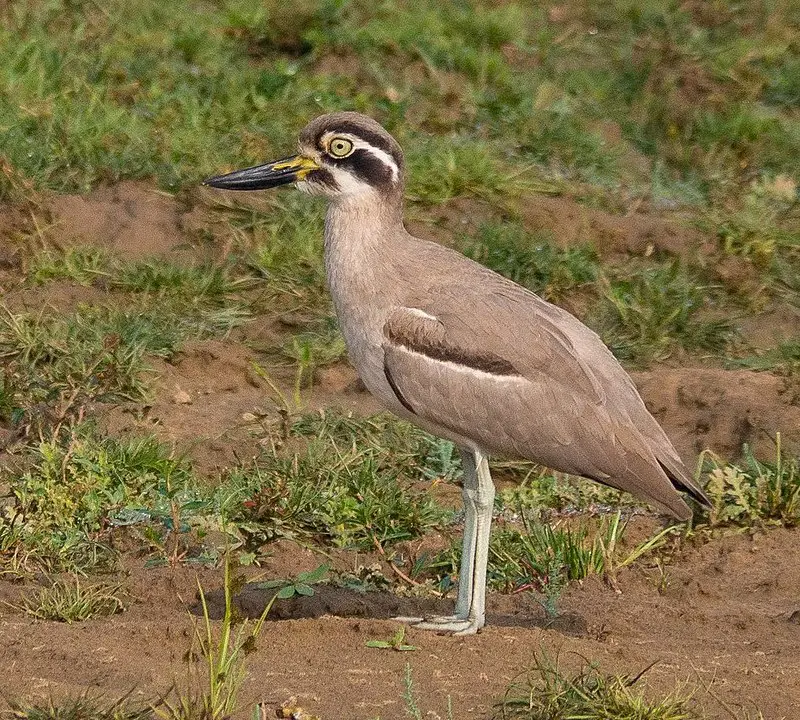
The Great Stone-Curlew, also known as the great thick-knee, is a large wader found in tropical southern Asia. It stands out with its long yellow legs and brownish plumage.
This bird was first described by French naturalist Georges Cuvier in 1829 who gave it the scientific name Oedicnemus recurvirostris, with Nepal being its type locality.
The species prefers to inhabit open country like steppes or grasslands where they hunt for prey on foot during night time while keeping watch from high perches during daybreak.
They are monogamous birds that breed between April – June and form strong pair bonds throughout their lifetime.
Scientific classification:
| Kingdom | Animalia |
| Phylum | Chordata |
| Class | Aves |
| Order | Charadriiformes |
| Family | Burhinidae |
| Genus | Esacus |
| Species | E. recurvirostris |
Also Featured In: Birds of Myanmar, Urban Birds of Hong Kong
24. Sociable Lapwing
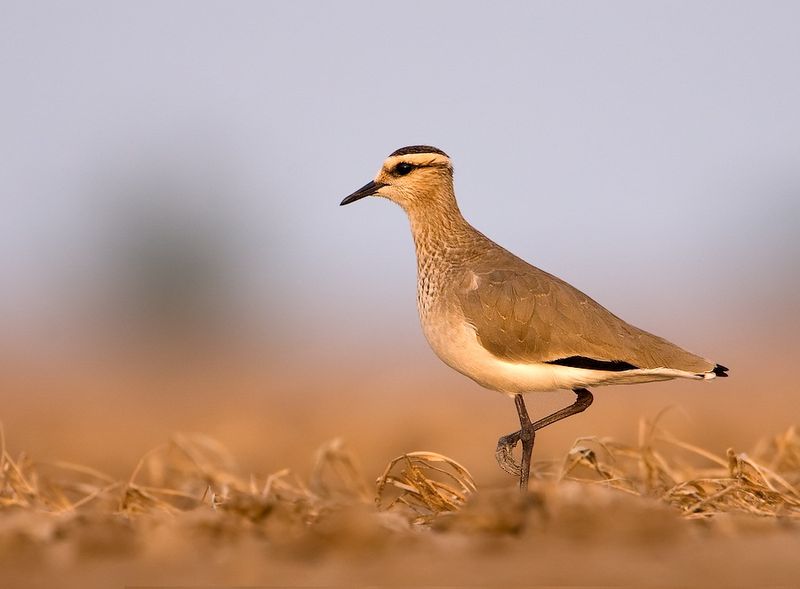
The Sociable Lapwing is an impressive wading bird of the plover family. It breeds in Kazakhstan, and migrates to spend its winter months in areas such as the Middle East, Indian Subcontinent, and Sudan.
Historically known as Black-bellied lapwing due to its black lower body feathers that contrast with white upper parts, it has a unique social behavior which earned it the name ‘Sociable’.
This species will often gather together into large flocks during migration but also form smaller groups while breeding or searching for food.
The male’s courtship display involves making loud calls from high places like rocks before diving down onto his chosen mate.
These birds are protected under international law since they have been hunted almost to extinction for their meat and feathers over past centuries.
Scientific classification:
| Kingdom | Animalia |
| Phylum | Chordata |
| Class | Aves |
| Order | Charadriiformes |
| Family | Charadriidae |
| Genus | Vanellus |
| Species | V. gregarius |
Also Featured In: Common Birds in Saudi Arabian, Flight Birds You Should Know
25. Painted Francolin
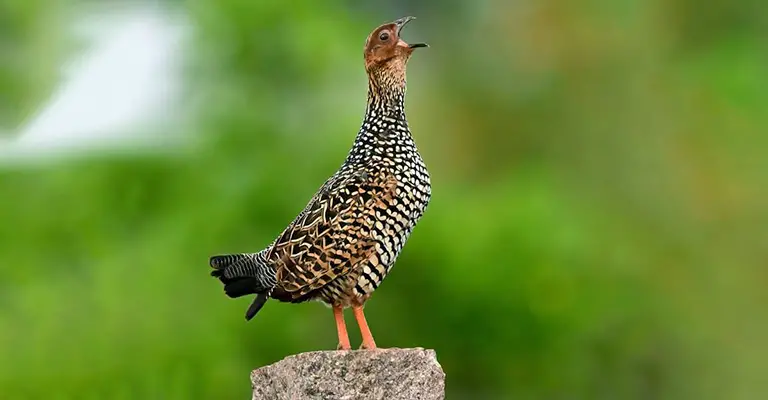
The Painted Francolin is a species of francolin found in grassy areas of India and Sri Lanka. During breeding season, they can be identified by their loud calls.
They are mainly distributed south to the Narmada river and east from the Western Ghats mountain range.
This bird has bright chestnut spots on its feathers which gives it an attractive appearance for avian enthusiasts or casual observers alike.
Its strong legs make up for its lack of flying ability as it prefers to run away rather than take flight when disturbed or threatened by predators.
The diet consists mainly of seeds, grains, insects and other small invertebrates that they find while scratching through leaf litter on the ground with their feet – making them very endearing birds indeed.
Scientific classification:
| Kingdom | Animalia |
| Phylum | Chordata |
| Class | Aves |
| Order | Galliformes |
| Family | Phasianidae |
| Genus | Francolinus |
| Species | F. pictus |
Also Featured In: Birds in Sri Lanka,
26. Green Imperial Pigeon
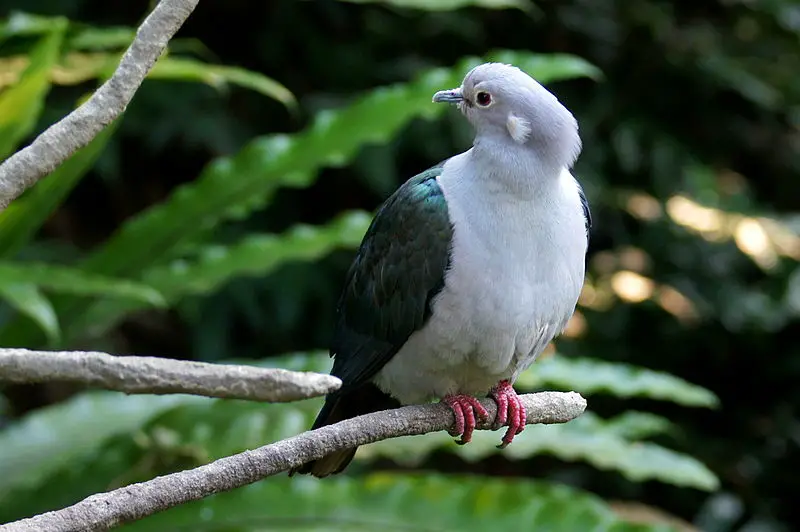
The Green Imperial Pigeon is a majestic bird found in the forests of Nepal, Southern India and Sri Lanka eastwards to southern China, Indonesia and the Philippines.
Measuring at around 37–44 cm long with an average wingspan of 63-71cm, this beautiful creature has deep green plumage on its body along with white patches underneath both wings which make it easily distinguishable from other birds.
In 1760 Mathurin Jacques Brisson described this species as “Le pigeon ramier des Moluques” or “P”. It feeds mainly on fruits like those from fig trees but also eats buds, flowers and arthropods when available.
The Green Imperial Pigeon builds nests mostly high up in tree hollows for protection against predators.
These pigeons are pretty shy animals so it’s important that we do our best not to disturb them while trying to observe their beauty.
Scientific classification:
| Kingdom | Animalia |
| Phylum | Chordata |
| Class | Aves |
| Order | Columbiformes |
| Family | Columbidae |
| Genus | Ducula |
| Species | D. aenea |
Also Featured In: Imperial Birds You Should Know, Most Common Tripura Birds You Need to Know
27. Purple Heron
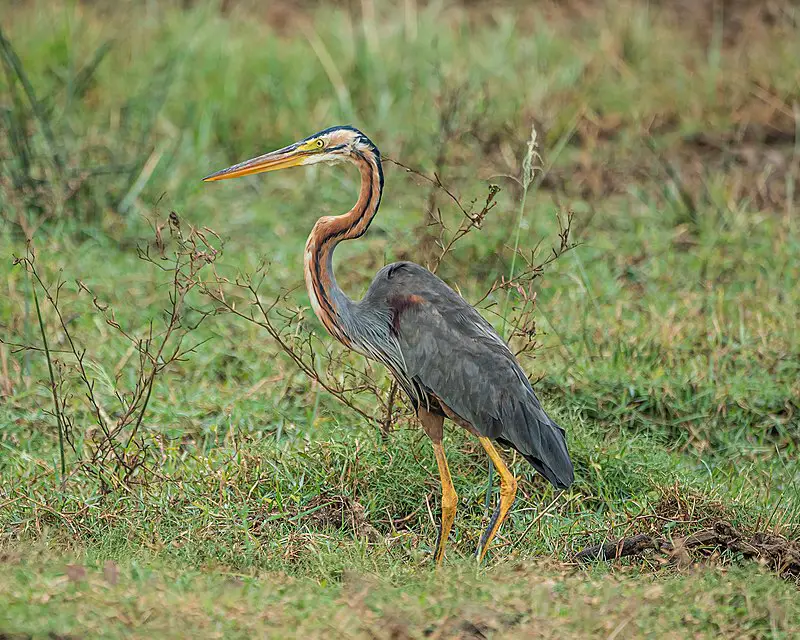
The Purple Heron is a majestic wading bird from the heron family which can be found in Africa, central and southern Europe, as well as southern and eastern Asia.
It has an impressive wingspan of up to 1.2 meters and its plumage usually ranges from grey-blue to purple on its back with brown streaks on it’s chest.
This species breeds during summer months before migrating for winter habitats where they feed mainly on fish or frogs near wetlands or rivers.
The scientific name Ardea purpureus originates from Latin words meaning ‘heron’ and ‘coloured purple’ respectively – referring to this bird’s beautiful colouration.
Scientific classification:
| Kingdom | Animalia |
| Phylum | Chordata |
| Class | Aves |
| Order | Pelecaniformes |
| Family | Ardeidae |
| Genus | Ardea |
| Species | A. purpurea |
Also Featured In: Most Beautiful birds of Greece, Ukrainian Birds You Should Know
28. Brown-Headed Gull
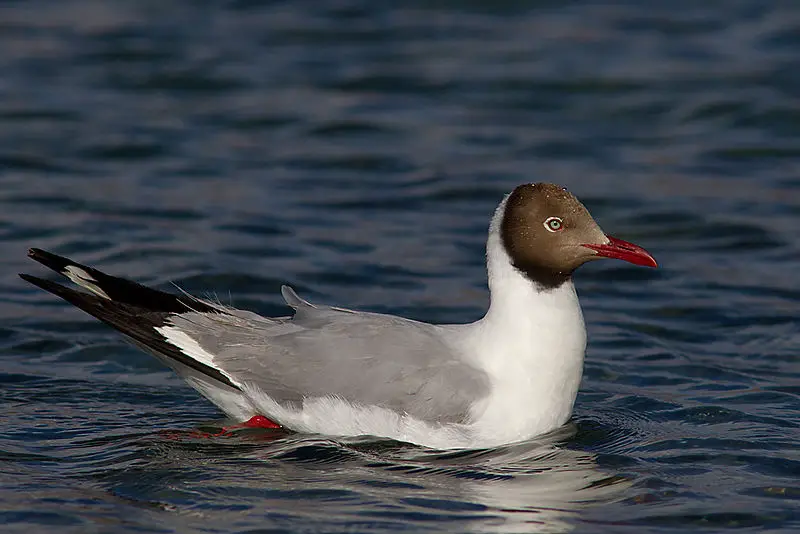
The Brown-headed Gull is a small species of gull that breeds in the high plateaus of Central Asia, from Tajikistan to Inner Mongolia.
During winter it migrates southward and can be seen along coastal areas and large inland lakes throughout the Indian Subcontinent.
They usually breed in colonies within reedbeds or marshes, constructing nests out of sticks on top of trees or among tall vegetation.
These birds have brown heads while their bodies are white with black wing tips; they also feature bright yellow eyes which give them an intense yet endearing look.
Their diet consists mainly fish but they’ll also consume insects, molluscs, crustaceans as well as other invertebrates and even plant matter during seasons when food is scarce.
Despite their shy nature towards humans these amazing birds make for wonderful wildlife watching opportunities.
Scientific classification:
| Kingdom | Animalia |
| Phylum | Chordata |
| Class | Aves |
| Order | Charadriiformes |
| Family | Laridae |
| Genus | Chroicocephalus |
| Species | C. brunnicephalus |
Also Featured In: Most Common Birds in Tajikistan, Birds of Ladakh
29. Slaty-Breasted Rail
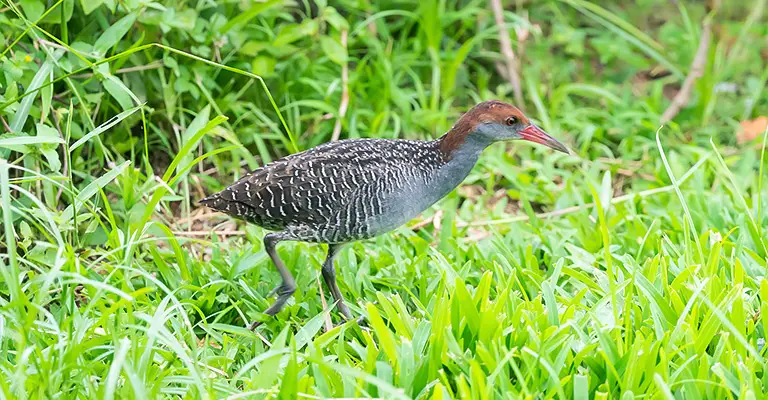
The Slaty-breasted Rail is a bird native to the Indian Subcontinent and Southeast Asia. During breeding season, they can be found near Dehradun in the foothills of India’s Himalayas.
This species has been placed in its own genus Lewinia due to new genetic studies which have now been accepted by the IUCN.
The plumage of this rail consists mainly of slaty grey with some black barring on its wings and tail feathers as well as vibrant chestnut flanks and belly.
It prefers habitats such as wetlands, muddy tidal flats or open grasslands for foraging where it searches for worms, insects and crustaceans among vegetation or mudflats respectively.
Despite being uncommon throughout much of their range these birds are not yet considered threatened – though further research into population numbers is necessary before we can fully understand their conservation status today.
Scientific classification:
| Kingdom | Animalia |
| Phylum | Chordata |
| Class | Aves |
| Order | Gruiformes |
| Family | Rallidae |
| Genus | Lewinia |
| Species | L. striata |
Also Featured In: Singapore Birds, Birds that Live in Kuala Lumpur
30. Black-Naped Monarch
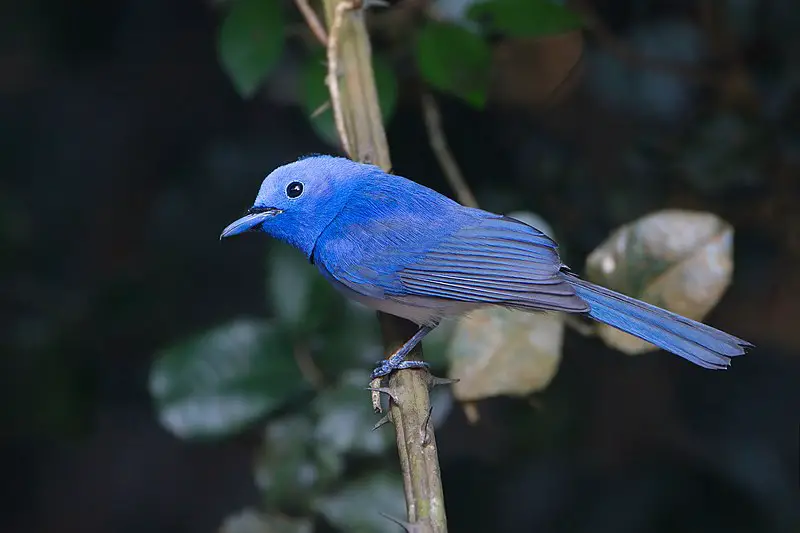
The Black-naped Monarch is a beautiful and agile passerine bird native to Southern and South East Asia.
With its distinct black patch on the back of it’s head, this small but strong species stands out among other birds in the area.
The male has vibrant blue plumage with an elegant narrow black half collar (“necklace”) which makes him even more attractive.
Females are comparatively duller with olive brown wings and light yellowish underparts which helps them blend into their environment better for camouflage purposes.
These birds feed mainly on insects, spiders and fruits making them beneficial as they help reduce pests while also providing nutrients to local vegetation by dispersing seeds from fruit consumption.
Scientific classification:
| Kingdom | Animalia |
| Phylum | Chordata |
| Class | Aves |
| Order | Passeriformes |
| Family | Monarchidae |
| Genus | Hypothymis |
| Species | H. azurea |
Also Featured In: Most Common Taiwan Birds, Common Birds of Lombok
31. Tufted Duck
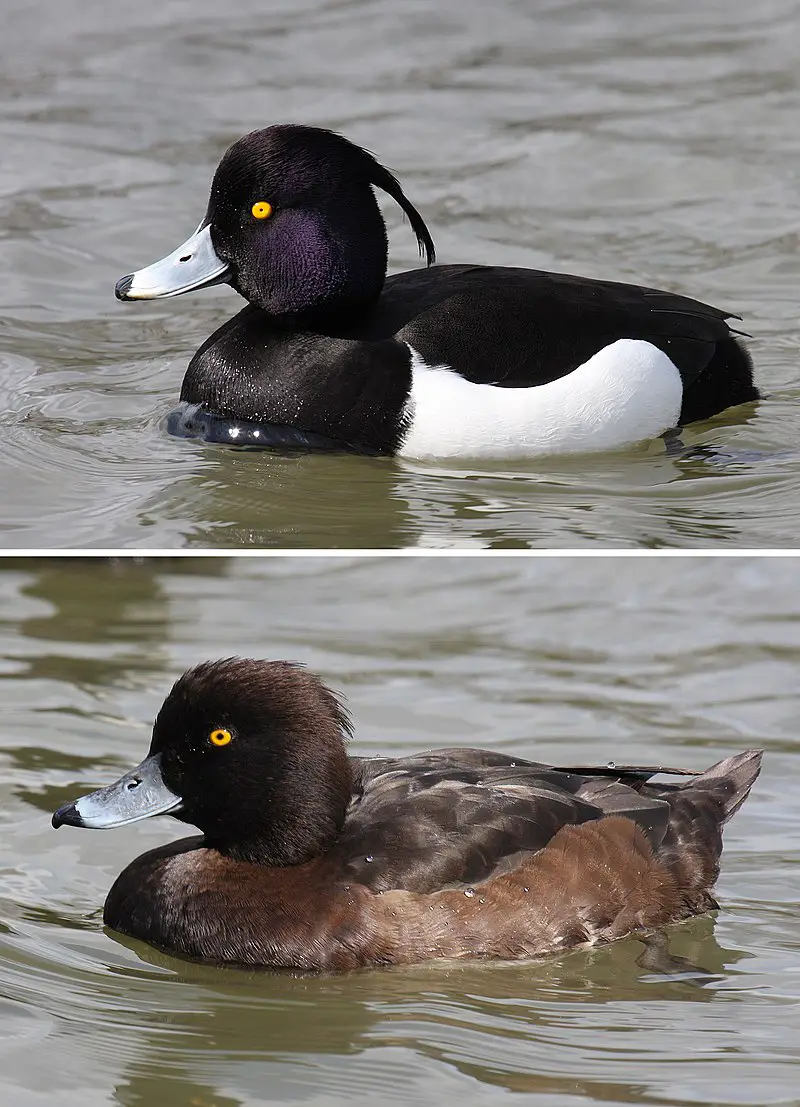
The Tufted Duck is a small diving duck which can be found in northern Eurasia, with an estimated population of nearly one million. It gets its scientific name from Ancient Greek and Latin words meaning “sooty throat”.
The adult male has black plumage except for white flanks and a blue-grey bill. Its head is also adorned by the distinctive tufts that give it its common name.
Females are brownish grey on their upper parts and have paler underparts than males as well as having orange bills instead of blue-grey ones like their male counterparts.
This species feed mainly on aquatic plants but will occasionally eat molluscs, crustaceans, insects or worms when they’re available too.
They are generally quite shy birds so keep your distance if you spot them while out in nature to avoid disturbing them unnecessarily
Scientific classification:
| Kingdom | Animalia |
| Phylum | Chordata |
| Class | Aves |
| Order | Anseriformes |
| Family | Anatidae |
| Genus | Aythya |
| Species | A. fuligula |
Also Featured In: Kuwait Birds, East African Birds
32. Greater Sand Plover
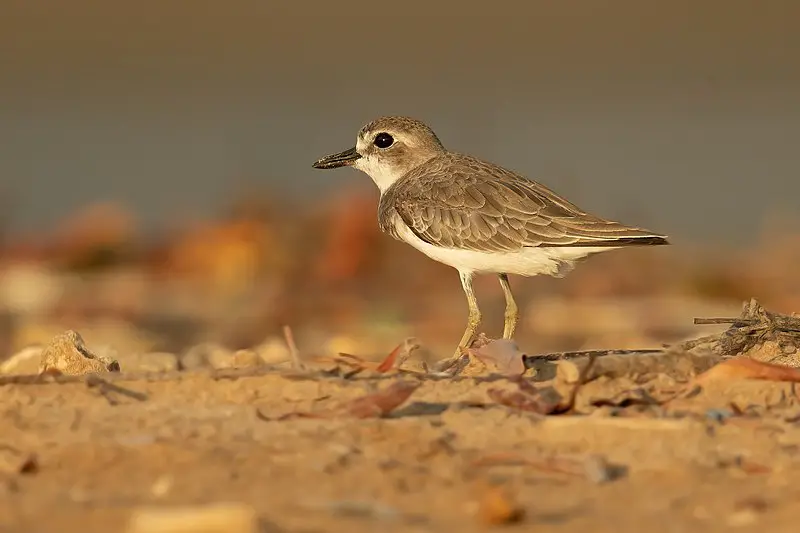
The Greater Sand Plover is a small wader, belonging to the plover family of birds. It’s scientific name Charadrius leschenaultii comes from the Latin word for a yellowish bird mentioned in the 4th century Vulgate.
These birds are typically found along coasts and sandy beaches where they feed on insects, mollusks and crustaceans.
They have grey-brown upperparts with white underparts and characteristic black bands across their chest as well as a prominent white forehead patch.
The Greater Sand Plovers breed mainly in India, Southeast Asia, Northern Australia and New Guinea while migrating to wintering grounds at coasts around South East Asia during nonbreeding season.
This species relies heavily on coastal wetlands so it is essential that these habitats be preserved in order for this species to survive into future generations.
Scientific classification:
| Kingdom | Animalia |
| Phylum | Chordata |
| Class | Aves |
| Order | Charadriiformes |
| Family | Charadriidae |
| Genus | Charadrius |
| Species | C. leschenaultii |
Also Featured In: Qatar birds, Native Birds Of Mackay
33. Scaly-Breasted Munia
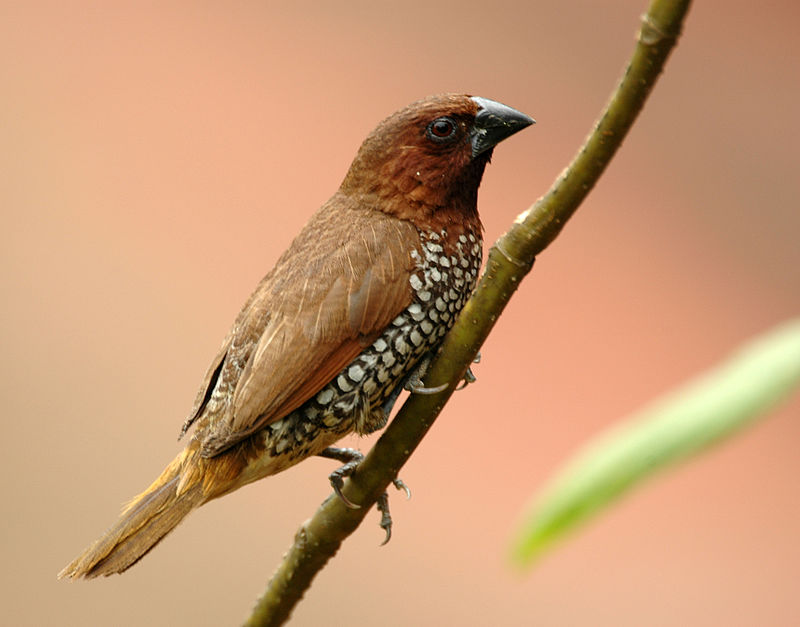
The Scaly-breasted Munia is a small estrildid finch native to tropical Asia. It was formally described and named by Carl Linnaeus in 1758, as its name suggests from the distinct scale-like feather markings on the breast and belly.
The adult bird has brown upperparts, with white lower parts spotted blackish-brown. Its head is pale grey or whitish with an orange beak and legs; the eyes are dark brown.
This species feeds mainly on grass seeds, but also eats insects such as caterpillars in some areas of their range during breeding season.
An interesting fact about this bird is that it builds its nest out of plant stems woven together into a cup shape suspended from trees or shrubs.
Overall they are quite common birds which can often been seen hopping around near human habitation looking for food scraps.
Scientific classification:
| Kingdom | Animalia |
| Phylum | Chordata |
| Class | Aves |
| Order | Passeriformes |
| Family | Estrildidae |
| Genus | Lonchura |
| Species | L. punctulata |
Also Featured In: Mauritius birds, Famous Paintings Birds
34. Shikra
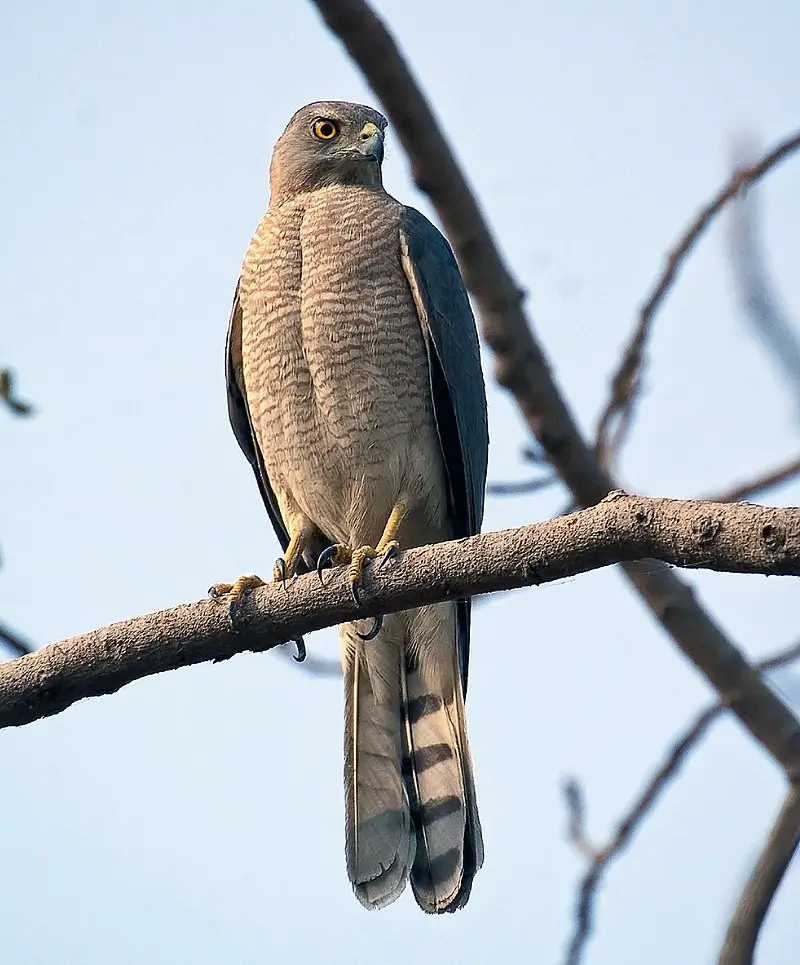
The Shikra bird, also known as the little banded goshawk, is a widespread bird of prey found in Asia and Africa. It is a small species belonging to the Accipitridae family.
The African variations of the Shikra may potentially represent a distinct species, but they are usually considered subspecies.
This bird has physical similarities to other sparrowhawk species, such as the Chinese Goshawk and Eurasian Sparrowhawk.
The Shikra is a quick predator and possesses excellent hunting skills. It typically preys on small mammals, reptiles, and birds.
The bird is known for its distinctive hunting technique, which involves a sudden dash and a quick silent strike to capture its victim.
Its plumage consists of brown or greyish-brown feathers with white and fine black streaks.
Overall, the Shikra bird is an impressive bird of prey, known for its versatility and hunting prowess.
Scientific classification:
| Kingdom | Animalia |
| Phylum | Chordata |
| Class | Aves |
| Order | Accipitriformes |
| Family | Accipitridae |
| Genus | Accipiter |
| Species | A. badius |
Also Featured In: Birds That Live in the Jungle, Native Birds of Kazakhstan
35. Long-Tailed Shrike
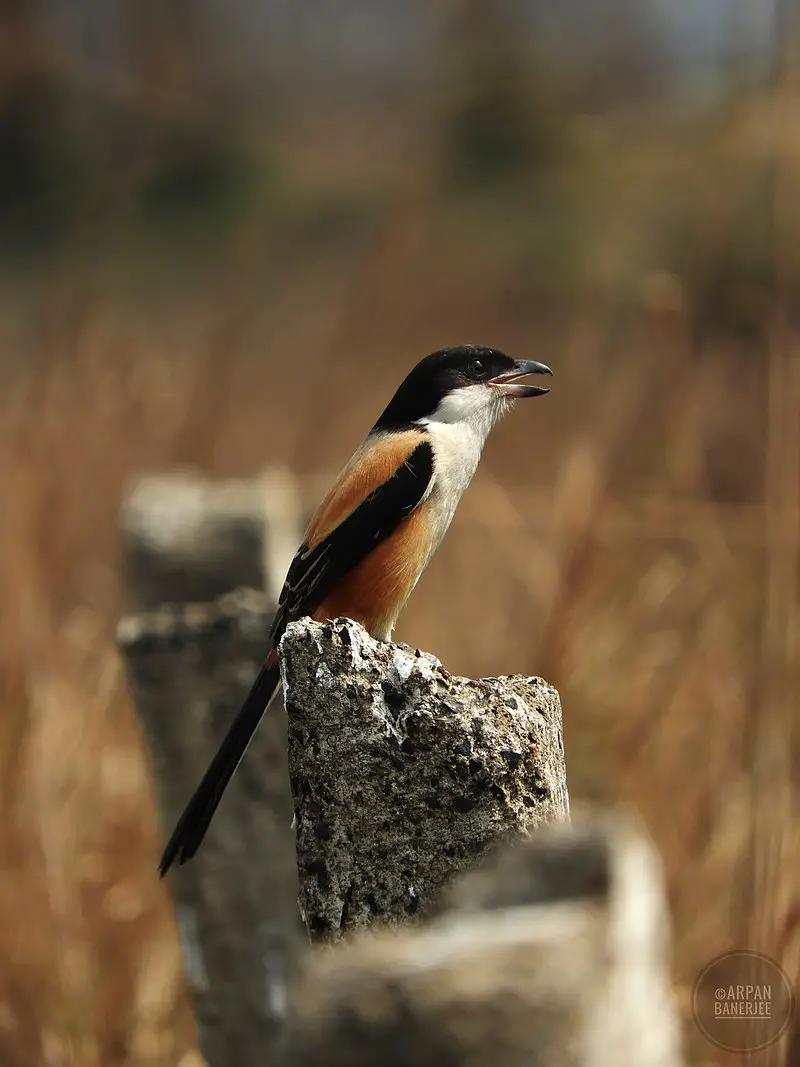
The Long-tailed shrike, also known as the rufous-backed shrike, belongs to the shrike family and is found throughout Asia.
Their appearance varies across their wide range, but they are known for their long tail and rufous-colored back.
In some areas, they are called the black-headed shrike. These birds prefer open habitats such as grasslands and farmland, where they hunt insects, lizards, and small birds
They are known for impaling their prey on thorns or barbed wire, making them easy to find.
Long-tailed shrikes are territorial and often seen perched on a high vantage point, scanning their surroundings for prey or intruders.
They are adaptable to human-made environments and have even been seen in cities. Despite their widespread range, their population is decreasing due to habitat loss and fragmentation.
Scientific classification:
| Kingdom | Animalia |
| Phylum | Chordata |
| Class | Aves |
| Order | Passeriformes |
| Family | Laniidae |
| Genus | Lanius |
| Species | L. schach |
Also Featured In: Common Birds in the Cities,
36. Spotted Owlet
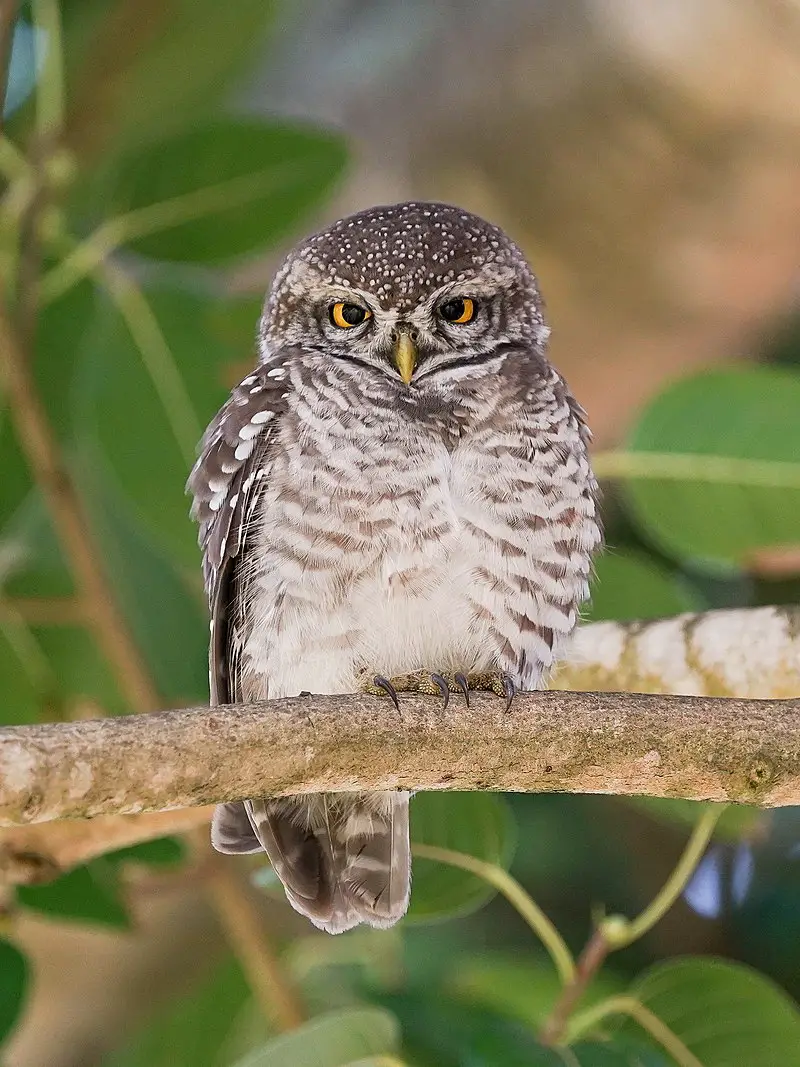
The Spotted owlet, also known as Athene brama, is a small bird species found in tropical Asia, from mainland India to Southeast Asia. It is a common resident of open habitats, including farmland and human habitation.
This bird has adapted well to living in urban areas and can be found roosting in small groups in cavities of trees, rocks or buildings.
They typically nest in holes in trees or buildings and lay 3-5 eggs. The Spotted owlet has shown great adaptability to changing environments and has learned to coexist with humans in urban settings.
This bird is known for its distinctive spotted appearance and has become a well-loved sight in many parts of Asia.
Scientific classification:
| Kingdom | Animalia |
| Phylum | Chordata |
| Class | Aves |
| Order | Strigiformes |
| Family | Strigidae |
| Genus | Athene |
| Species | A. brama |
Also Featured In: Common Birds that Live in Odisha, Common Birds in Bangalore
37. River Tern
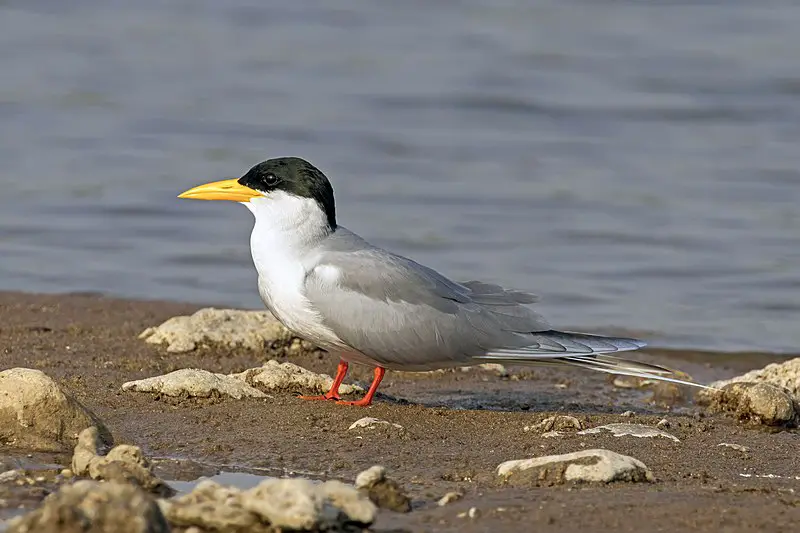
The River tern bird, scientifically known as Sterna aurantia, is a member of the Laridae family. It resides along inland rivers in the Indian Subcontinent, Iran, and eastern Myanmar to Thailand.
This bird is uncommon in Thailand. It is known for living almost exclusively in freshwater, contrary to other species in the same family.
Usually quiet when away from breeding grounds, River terns become vocal during their breeding period, which ranges from March to May.
The River terns build their nests in colonies.
Scientific classification:
| Kingdom | Animalia |
| Phylum | Chordata |
| Class | Aves |
| Order | Charadriiformes |
| Family | Laridae |
| Genus | Sterna |
| Species | S. aurantia |
Also Featured In: Gujarati Birds, Birds that Live in Rajasthan
38. Nilgiri Wood Pigeon
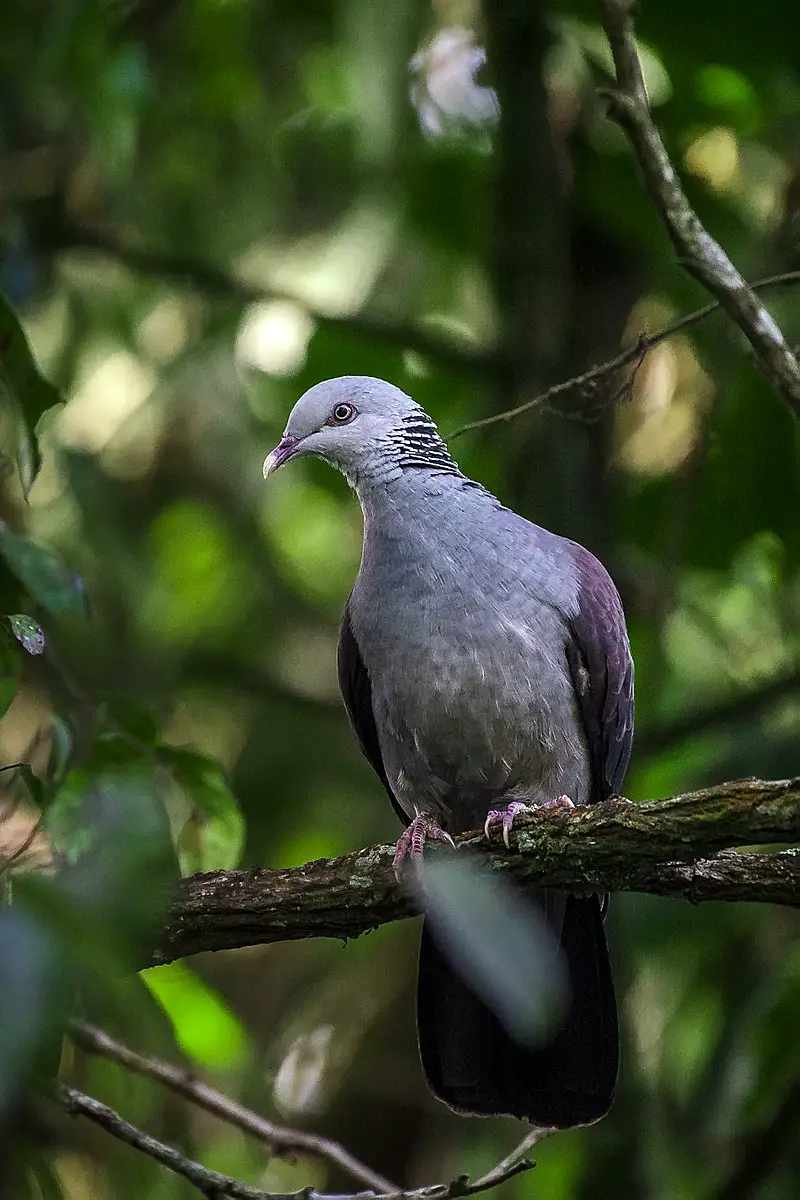
The Nilgiri wood pigeon is a bird that is found in the moistness of the Western Ghats in southwestern India. Mainly feeding on fruits, it can be seen foraging in the canopy of dense hill forests.
It can be easily identified in the field by its size, dark colors and the unique checkerboard pattern on its nape. This bird possesses a dark grey and black plumage that makes it quite distinctive.
Scientific classification:
| Kingdom | Animalia |
| Phylum | Chordata |
| Class | Aves |
| Order | Columbiformes |
| Family | Columbidae |
| Genus | Columba |
| Species | C. elphinstonii |
Also Featured In: Common Birds in Kerala, Pet Birds that Live in India
39. Indian Nightjar
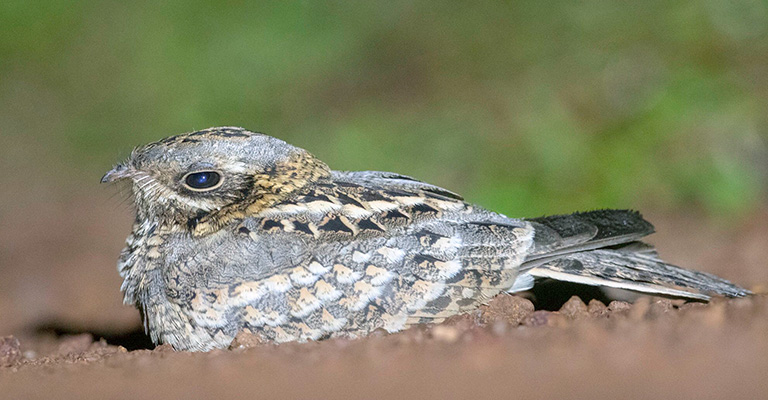
The Indian nightjar is a tiny bird that inhabits open areas in South and Southeast Asia. It is known for its nocturnal habits and distinct calls, which resemble the sound of a stone skipping on ice.
This bird is crepuscular, meaning that it is most active during dawn and dusk. Although it is not often seen, it can be identified by its unique clicking calls.
The Indian nightjar is a resident breeder, which means it stays in one area year-round and breeds there.
This bird chooses its habitat carefully, preferring open landscapes where it can easily find insects to feed on during the night.
Overall, the Indian nightjar is a fascinating and elusive bird that adds to the diversity of birdlife in Asia.
Scientific classification:
| Kingdom | Animalia |
| Phylum | Chordata |
| Class | Aves |
| Clade | Strisores |
| Order | Caprimulgiformes |
| Family | Caprimulgidae |
| Genus | Caprimulgus |
| Species | C. asiaticus |
Also Featured In: Birds that Live in Tamil Nadu, Birds of Andhra Pradesh
40. Brown Crake
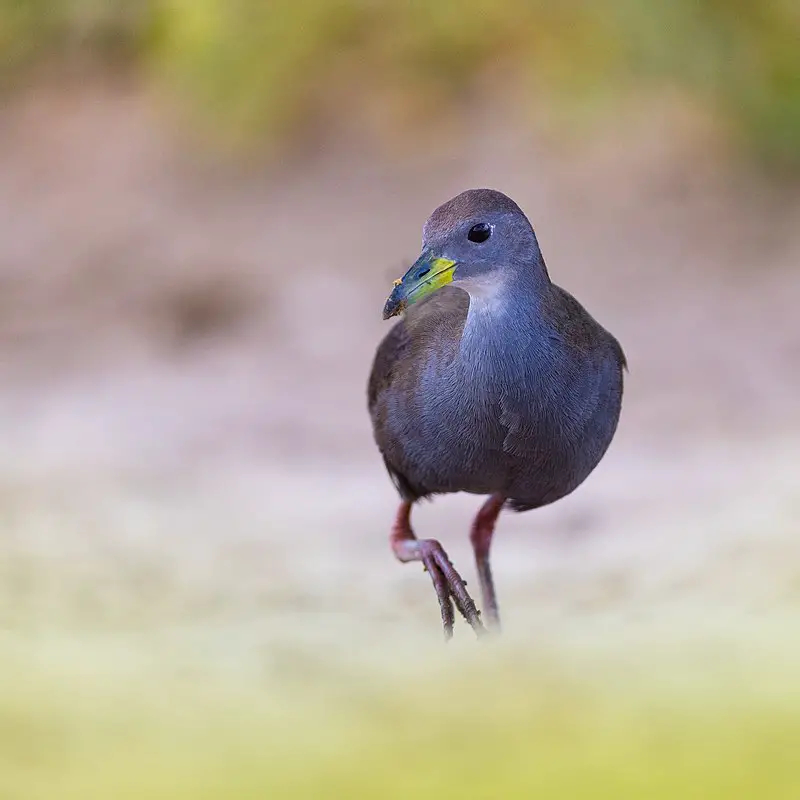
The Brown crake, also known as the Brown bush-hen, is a type of waterbird from the Rallidae family found in southern Asia.
The exact origin of the name “akool” is uncertain, although it may have ties to Hindu mythology or the Sinhalese language.
This species is known to reside in wetland areas and feeds on insects, small fish, and aquatic plants. The Brown crake is a small, elusive bird with brown plumage and a distinctive red bill.
Despite being a relatively common species, they are not often seen due to their shy nature and habitat preferences.
Overall, the Brown crake is an interesting and important member of the aquatic bird community in South Asia.Scientific classification:
| Kingdom | Animalia |
| Phylum | Chordata |
| Class | Aves |
| Order | Gruiformes |
| Family | Rallidae |
| Genus | Zapornia |
| Species | Z. akool |
Also Featured In: Common Birds of Chhattisgarh,
41. Forest Owlet
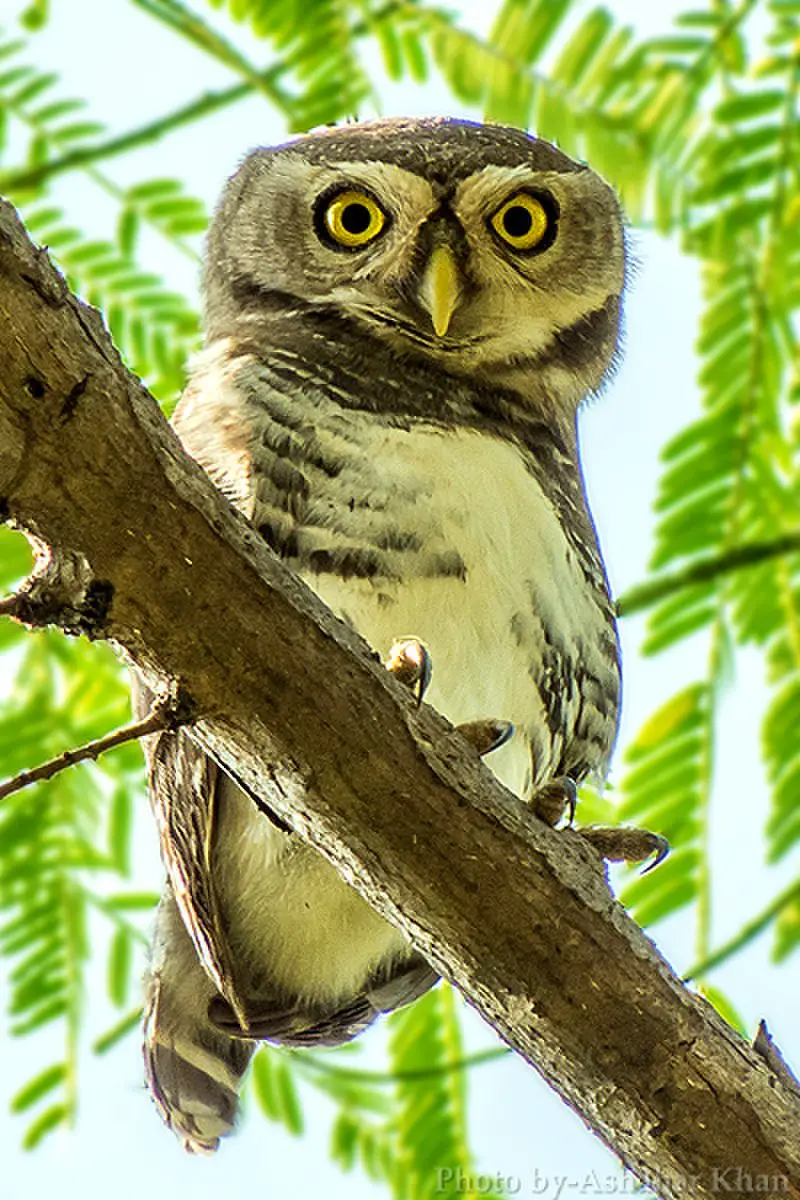
The forest owlet, also known as Athene blewitti, is a bird species that can only be found in the lush forests of central India.
Unfortunately, this bird is considered an endangered species, with a population of less than 1,000 mature individuals.
The main threat to its survival is the loss of habitat due to deforestation. The forest owlet belongs to the Strigidae family of typical owls and was first discovered in 1873.
It was presumed extinct after not being spotted in 1884. However, it was rediscovered and listed as endangered in 2018.
Conservation efforts are being made to save this species from extinction.
Scientific classification:
| Kingdom | Animalia |
| Phylum | Chordata |
| Class | Aves |
| Order | Strigiformes |
| Family | Strigidae |
| Genus | Athene |
| Species | A. blewitti |
42. Pied Harrier
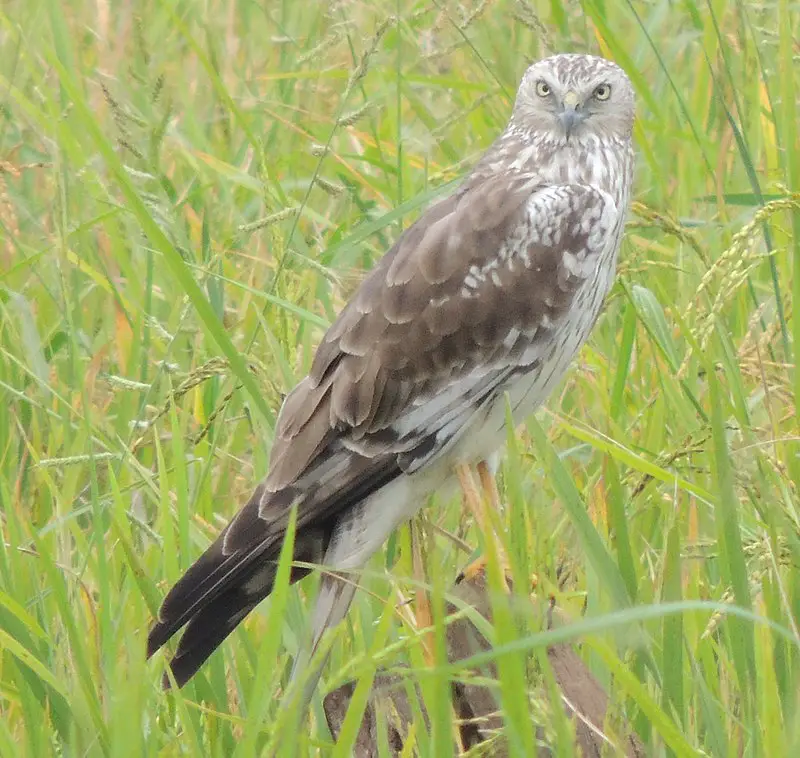
The pied harrier is a migratory bird of prey native to Asia. Its breeding range covers the Amur valley in Russia, northeastern China and North Korea.
During winters, these birds can be found in areas ranging from Pakistan to the Philippines.
The species is known to consist of a population of about 10,000 individuals, which is thought to be experiencing a moderate decline.
Its scientific name is Circus melanoleucos. Despite being a bird of prey, the pied harrier feeds mainly on insects and small mammals, such as rats and mice.
It is a stunningly beautiful bird with distinctive black and white plumage, making it easily distinguishable from other raptors.
Due to its current population status and the rate of decline, the pied harrier is receiving increased conservation attention.
Scientific classification:
| Kingdom | Animalia |
| Phylum | Chordata |
| Class | Aves |
| Order | Accipitriformes |
| Family | Accipitridae |
| Genus | Circus |
| Species | C. melanoleucos |
43. Ruddy-Breasted Crake
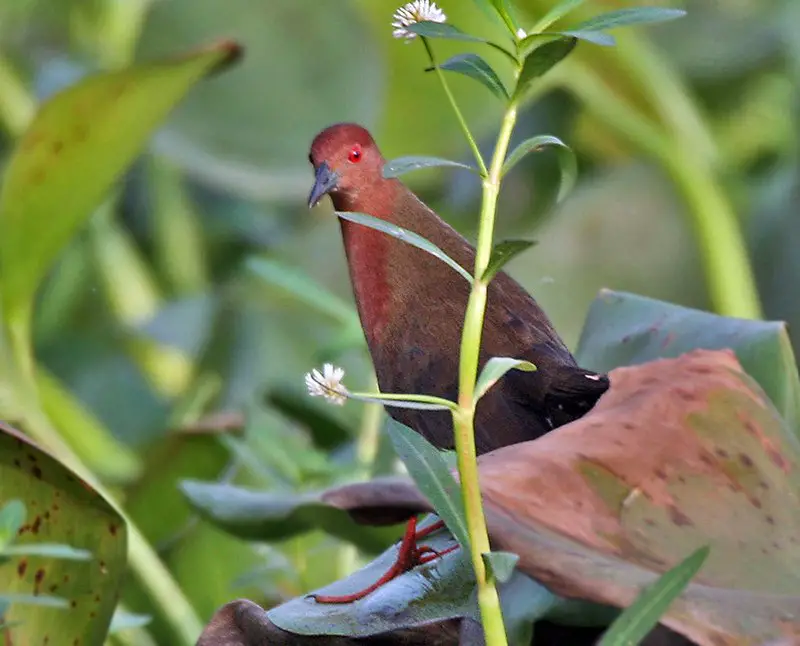
The ruddy-breasted crake, also known as the ruddy crake, belongs to the rail and crake family Rallidae. This waterbird can be found in swamps and wet areas across South Asia, including the Indian subcontinent, south China, Japan, and Indonesia.
Although it is typically a permanent resident throughout its range, it has been recorded as a vagrant in Australia’s Christmas Island.
The breeding habitat of these birds is characterized by swampy areas with sufficient water supply. As the name suggests, the ruddy-breasted crake features a reddish-brown breast and is relatively small in size.
Despite being well distributed, not much is known about these elusive birds. Even with its small size, the ruddy-breasted crake is known for its distinctive call, which can be heard echoing across the waterways where it lives.
Scientific classification:
| Kingdom | Animalia |
| Phylum | Chordata |
| Class | Aves |
| Order | Gruiformes |
| Family | Rallidae |
| Genus | Zapornia |
| Species | Z. fusca |
44. Jerdon’s Nightjar
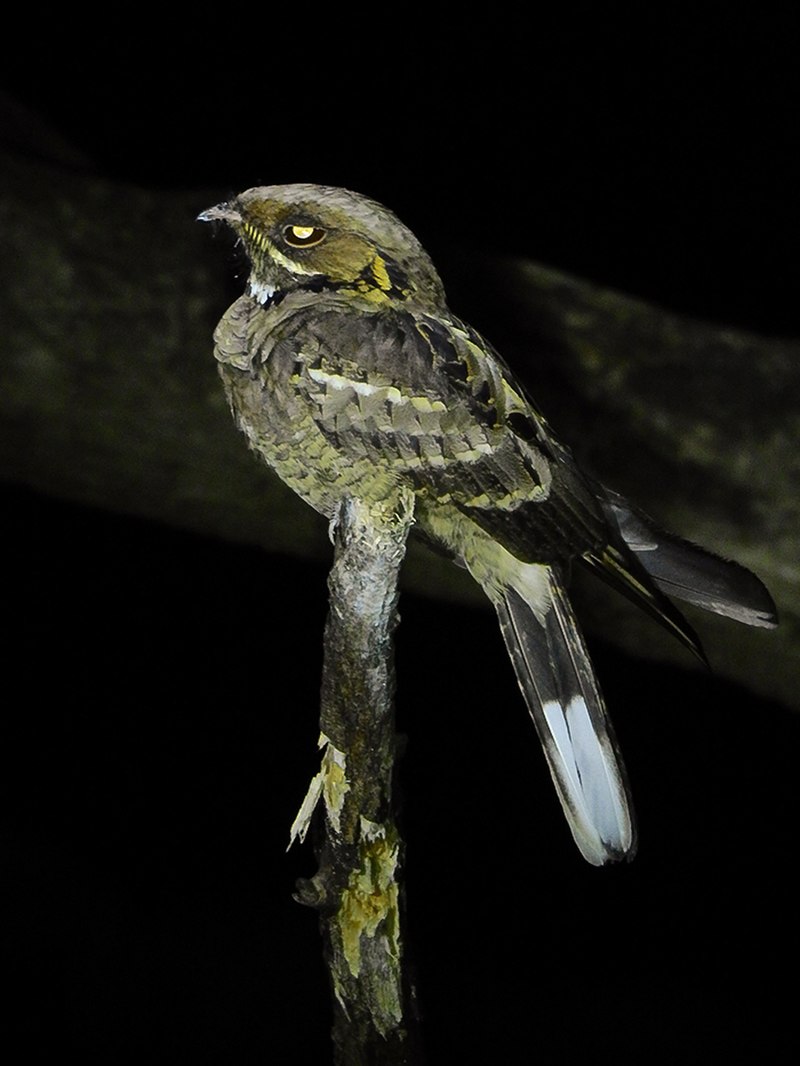
Jerdon’s nightjar is a medium-sized bird found in southern India and Sri Lanka. Its unique call resembles the sound of a wooden plank being beaten at regular intervals, ending in a tremolo.
It was initially considered a sub-species of the long-tailed nightjar but is now recognized as a distinct species. The bird is named after Thomas C. Jerdon, who was the first to describe it.
It has a distinct appearance and is easily recognizable because of its call. Jerdon’s nightjar is a nocturnal bird, making it difficult to spot during the day.
While not much is known about its behavior and habitat, it is an important species in the ecological balance of the region, and conservation efforts are being made to protect it.
Scientific classification:
| Kingdom | Animalia |
| Phylum | Chordata |
| Class | Aves |
| Clade | Strisores |
| Order | Caprimulgiformes |
| Family | Caprimulgidae |
| Genus | Caprimulgus |
| Species | C. atripennis |
45. Rain Quail
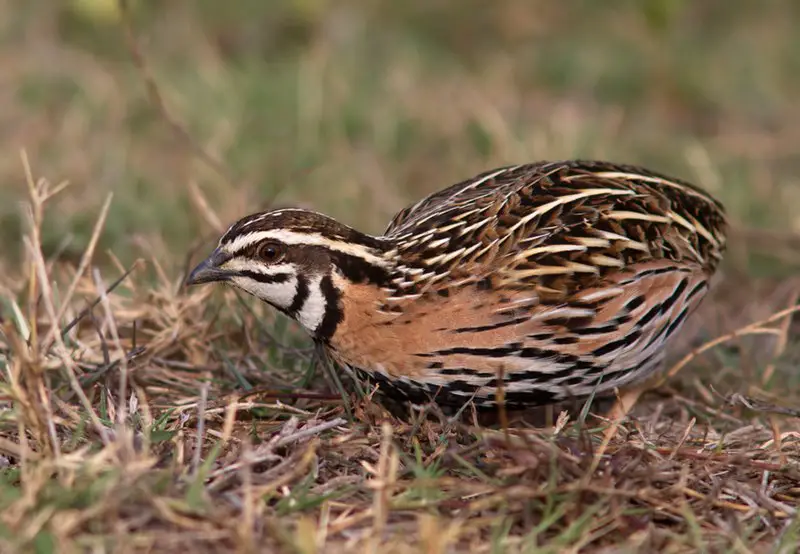
The rain quail, also known as the black-breasted quail, is a species of bird found in South-east Asia and the Indian Sub-continent. Its habitat includes countries such as Pakistan, India, Sri Lanka, Nepal, Vietnam, Myanmar, Cambodia, and Bangladesh.
The bird was first described by German naturalist Johann Friedrich Gmelin in 1789. With black stripes on its head, the rain quail is small and has a distinct appearance.
Interestingly, the bird is known by the name “rain quail” because it is believed to prefer breeding and nesting during the rainy season.
This bird species has importance in game hunting and is considered a delicacy in some parts of the world.
Scientific classification:
| Kingdom | Animalia |
| Phylum | Chordata |
| Class | Aves |
| Order | Galliformes |
| Family | Phasianidae |
| Genus | Coturnix |
| Species | C. coromandelica |
46. Savanna Nightjar
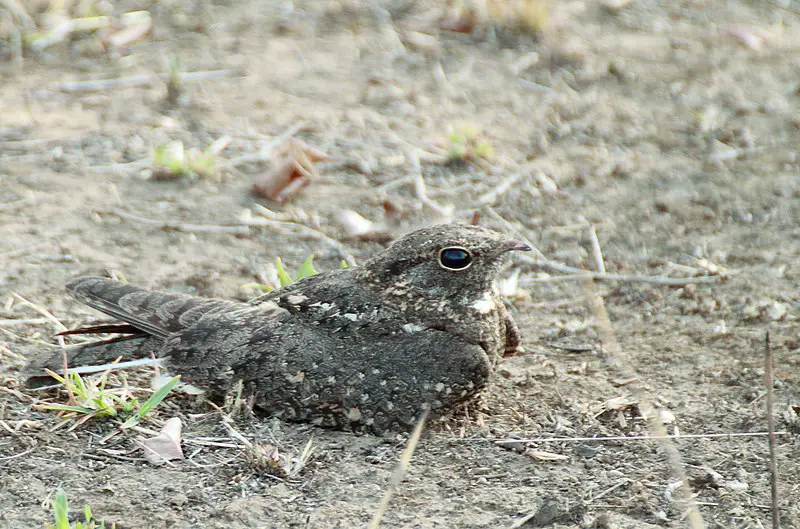
The savanna nightjar, also known as the allied nightjar or Franklin’s nightjar, is a species of bird found in South and Southeast Asia. This nocturnal bird inhabits open forests and scrub areas.
It is known to have eight subspecies, including monticolus, amoyensis, and stictomus. The savanna nightjar is of medium length and has distinct features such as a broad bill and a well-camouflaged plumage.
It is also known for its unique vocalization during the night. This bird’s survival depends on the conservation of its natural habitat, and efforts for this are underway.
Hence, the savanna nightjar is a fascinating and significant species in the avian world.
Scientific classification:
| Kingdom | Animalia |
| Phylum | Chordata |
| Class | Aves |
| Clade | Strisores |
| Order | Caprimulgiformes |
| Family | Caprimulgidae |
| Genus | Caprimulgus |
| Species | C. affinis |
Also Featured In: Most Common Madhya Pradesh Birds,